| |||||||
| Search Forums |
| Advanced Search |
| Go to Page... |
 |
| Search this Thread |  764,195 views |
| | #1 |
| Team-BHP Support  Join Date: Apr 2016 Location: Mumbai
Posts: 2,408
Thanked: 25,654 Times
| Tata Tigor : Official Review The Tata Tigor is on sale in India at a price of between Rs. 4.70 - 7.09 lakhs (ex-Delhi). What you’ll like: • Great styling. A chic-looking compact sedan. Solid build too • Tata has put in a lot of effort on quality and it shows • Well-priced for what it offers; undercuts all the direct competitors • High quality, nicely designed cabin. Lots of storage and a segment best 419-litre boot • Good driveability (both engines), a compliant ride & neutral road manners • Amazing 8-speaker Harman entertainment system. Sounds top class! • Feature list with 2 driving modes, parking sensors, cooled glovebox, touchscreen ICE etc. What you won't: • Mediocre 3-cylinder engines. They lag behind the competition in performance & refinement • Most other compact sedans have standard airbags. The Tigor doesn’t (only on top variant) • Concerns over long-term reliability, more so of the freshly developed engines • 6-month service interval is too frequent! A 1 year interval is the segment norm • A rare Tata car that cannot seat 5 (best for 4 adults) • Tata's after-sales experience remains a gamble. Service quality is far from that of Maruti & Hyundai The 2024 Tigor iCNG AMT • Review Link Last edited by Aditya : 21st February 2024 at 17:09. |
| |  (54)
Thanks (54)
Thanks
 |
| The following 54 BHPians Thank Omkar for this useful post: | amit_purohit20, ampere, amrutmhatre90, Ani0404, AutoIndian, Avikbrio, blackwasp, CarguyNish, carrazy, dailydriver, damodar, dZired, Flyer, glomus123, Grand Drive, GTO, hemanth.anand, Hot_nut, iliketurtles, Ironhide, jagzrk, Jakku, LoneRidder, manij, MDED, myavu, Nohonking, noopster, NPV, phoenixash, Ponbaarathi, Rajeevraj, RavenAvi, red.devil_19, rj22, S.MJet, samabhi, samaspire, sayakc, Simhi, SmartCat, SnS_12, swiftnfurious, theexperthand, theredliner, uday.ere, Udit, vaasu, vaish9925, vb-saan, VeluM, Vik0728, vishy76, vsrivatsa |
| |
| | #2 |
| Team-BHP Support  Join Date: Apr 2016 Location: Mumbai
Posts: 2,408
Thanked: 25,654 Times
| Review Index: Exterior Last edited by GTO : 25th June 2017 at 11:15. |
| |  (16)
Thanks (16)
Thanks
 |
| The following 16 BHPians Thank Omkar for this useful post: | Ani0404, CarguyNish, dZired, Flyer, GTO, Ironhide, MDED, Nohonking, phoenixash, Ponbaarathi, RavenAvi, SnS_12, theexperthand, Torino, vaish9925, vb-saan |
| | #3 |
| Team-BHP Support  Join Date: Apr 2016 Location: Mumbai
Posts: 2,408
Thanked: 25,654 Times
| Exterior 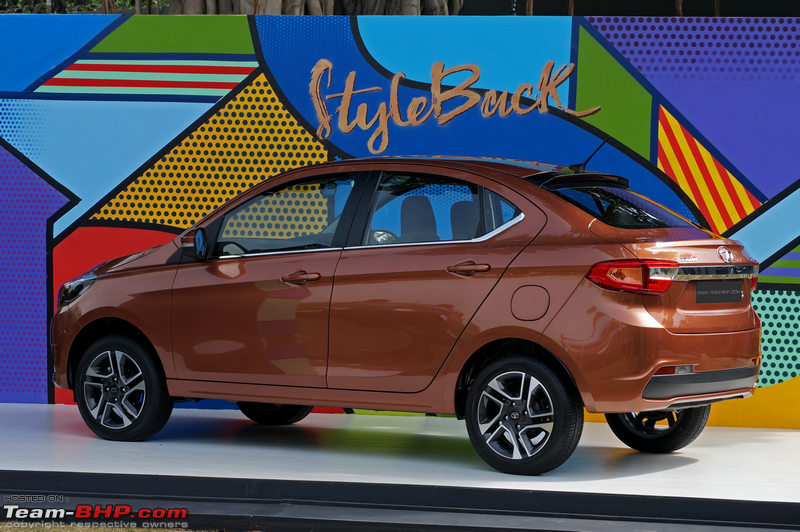 The wheels are finally spinning for Tata. The much talked about Impact design philosophy is finally bearing some results for the Indian manufacturer and Tata is betting big on it. After the whole Zica-Tiago fiasco, Tata seems be handling its launches better. The Tiago was launched in April last year, the Hexa came out in January this year and within a couple of months, we had the Tigor. Tata Motors aims to be a consistent no.3 player on the sales charts. While other manufacturers play it safe by having just one car in this segment, Tata manages to handle two...and has introduced yet another one. Though the thing to note here is that the two existing cars (Indigo eCS and Zest) are based on the old Indica platform and X1 platform respectively, the Tigor is based on the all-new Tiago platform. Currently, Tata Motors sells cars which are based on 6 platforms and the company will be limiting the number of platforms to just 2, which will therefore mean goodbye to the ageing Indigo eCS. The Tiago set the ball rolling for Tata, and received much needed appreciation in an area where they were struggling - design. Even BHPians voted it as the 2016 car of the year (related thread). Being placed in the B1 segment, the Tiago is doing its job well by drawing some considerable numbers to the Tata stable (coasting at around 4,000 to 5,000 units per month). It'll be interesting to see with all the efforts to not make the Tigor look like a typical compact sedan, will it be able to make an impact on the Indian customer? Only time will tell. 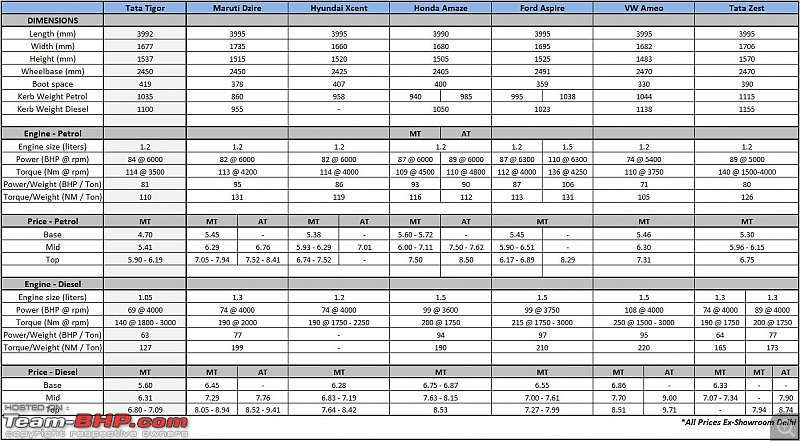 In a segment which is filled with ordinary looking compact sedans, the 'Styleback' - as Tata likes to call it - does stand out from the crowd. The basic philosophy behind the Tigor was the proper integration of the third box, and not making it seem like a boot plastered on a hatchback. Based on the same platform as the Tiago, the Tigor has a 50 mm longer wheelbase. Tata started working on the Tiago in 2012 and the Tigor in 2013. In order to make a sedan out of the Tiago, Tata had to consider a couple of options. First one was to just go by the usual method of adding a boot to the hatchback like most of the sedans (Dzire, Xcent, Ameo, Amaze) or go for a notch-back design (Verito Vibe). Here's how the Tigor would have looked if Tata would have gone with either of these options:  The Tigor was displayed as 'Kite 5' at the Auto Expo last year (related post). Many people were glad to see that most of these design elements had in fact made it to the production model. The name wasn't finalized back then and there were rumors that the compact sedan could be named as Viago/Altigo. Thank the Gods that Tata vetoed these names and came up with 'Tigor'. In terms of head-on styling, there are a lot of similarities with the hatchback sibling, but it manages to differentiate itself a little via a different headlamp cluster. The side profile doesn’t look mundane, and is slightly similar to the notchback profile (though not entirely). The boot looks well integrated with the design curves of the profile, and not like a third box attachment. The rear reminds me of the first generation XF facelift. Looking at it from an angle, you will notice that the car doesn't have a squatted stance, but feels like it has been lifted up from the back. The base variants of the Tigor run on 13-inch steel rims, while the mid variants get 14 inchers. The top-end variants get alloy wheels; the diesel variants are shod with 14-inch wheels & the petrol variants get 15-inch alloys. Just like the Tiago, you won't find any engine badges on the Tigor. The rear bumper gets a black insert at the bottom similar to something we'd recently seen on the Ignis, albeit this is a smaller one. If you look closely, you will see that the parking sensors placed on the rear bumper aren't on a single level like the Tiago. The ones in the middle are placed on this black plastic insert and the two on the sides are placed slightly higher on the bumper. Tata claims that the placement will detect objects in a better way. The car is slightly smaller than the Zest and measures 3,992 mm in length, 1,677 mm in width and 1,537 mm in height. If you compare the dimensions with the Tiago, the length has obviously gone up by 246 mm. The wheelbase has been stretched by 50 mm and you might notice that the car is 30 mm wider. There are no extra additions to the body which have made the car wider. In fact, the front and rear track of the car are same as the Tiago at 1,400 mm and 1,420 mm respectively. The extra width is purely a result of the design. The side character lines of the Tigor are at the same angle as that of the Tiago and hence, the increased length also leads in the extension of these lines towards the rear of the car. This is the reason why the car gains some more width as compared to the hatchback sibling. The low starting price of the Tigor which undercuts all the cars in competition is a result of stripping the base variants of features. The Ministry of Road Transport and Highways had recently released a statement saying that airbags are to be mandated as a standard feature on all new cars, starting from October 2017 (related discussion). Didn't really understand what Tata was thinking, providing airbags only on the top-end variant  ! Even the Tiago gets airbags as an option from the mid variant. Other manufacturers like Maruti, Hyundai, Ford and Volkswagen surely have gotten their ducks in a row by making airbags standard across the line-up with the Dzire, Xcent, Aspire and Ameo. It will be a fair comparison of price only when airbags are made mandatory across all the variants. Having said that, the higher variants are indeed well priced for the equipment they offer and are sure to attract quite a few customers. ! Even the Tiago gets airbags as an option from the mid variant. Other manufacturers like Maruti, Hyundai, Ford and Volkswagen surely have gotten their ducks in a row by making airbags standard across the line-up with the Dzire, Xcent, Aspire and Ameo. It will be a fair comparison of price only when airbags are made mandatory across all the variants. Having said that, the higher variants are indeed well priced for the equipment they offer and are sure to attract quite a few customers. Big shoutout to BHPian amrutmhatre90 for letting us drive his family's brand-new car for this review. Thank you! Tata Motors was unable to arrange a media car for us in Mumbai: 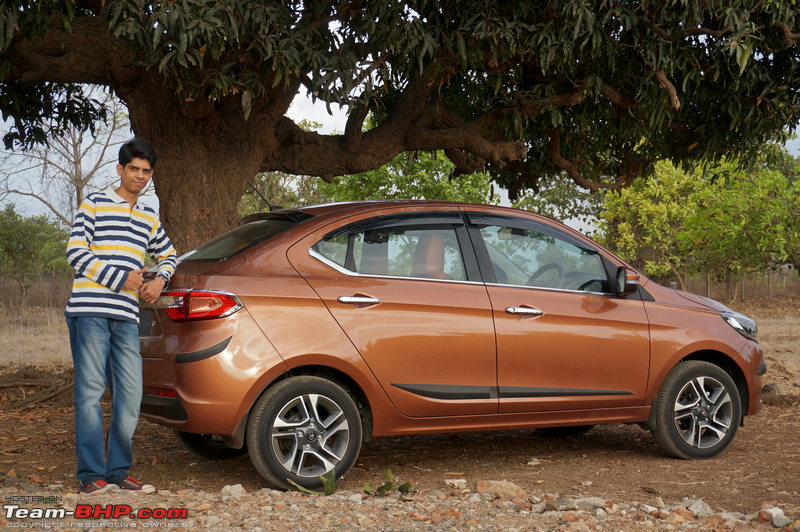 The smiling front grille from the Tiago looks cute even on the Tigor. The smoked projector headlamps differentiate the compact sedan from its hatchback sibling: 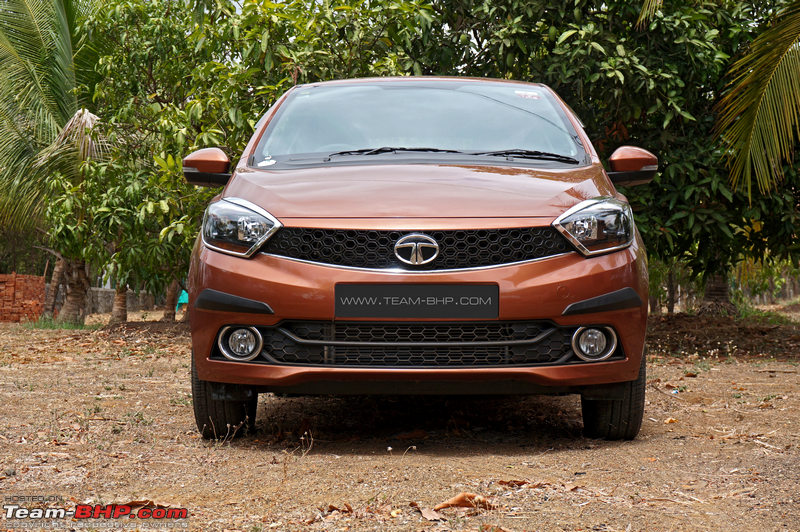 A thick chrome strip running across the boot catches your eye. The bumper juts out slightly from the sides which gives it a slightly curvy look. It also houses 4 parking sensors and a black insert: 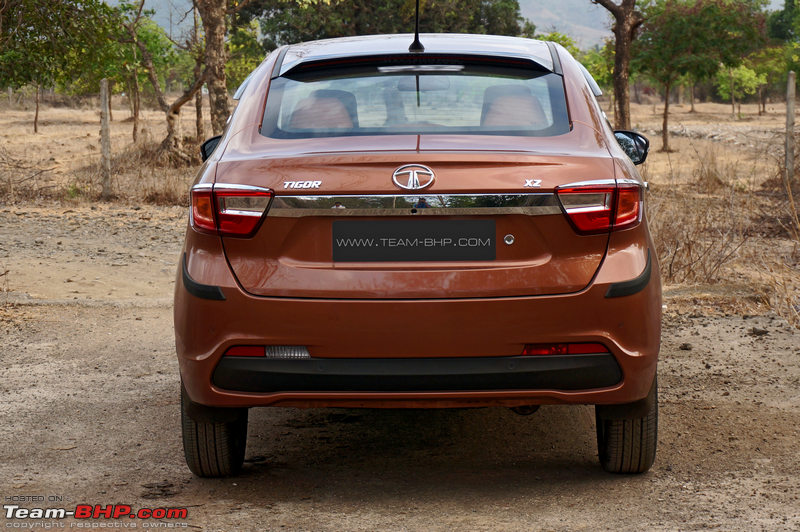 The roofline integrates with the boot quite nicely. It has a wheelbase of 2,450 mm which is equivalent to the current generation Dzire and 50 mm more than the Tiago. Do note that this customer car has some after-market accessories on it: 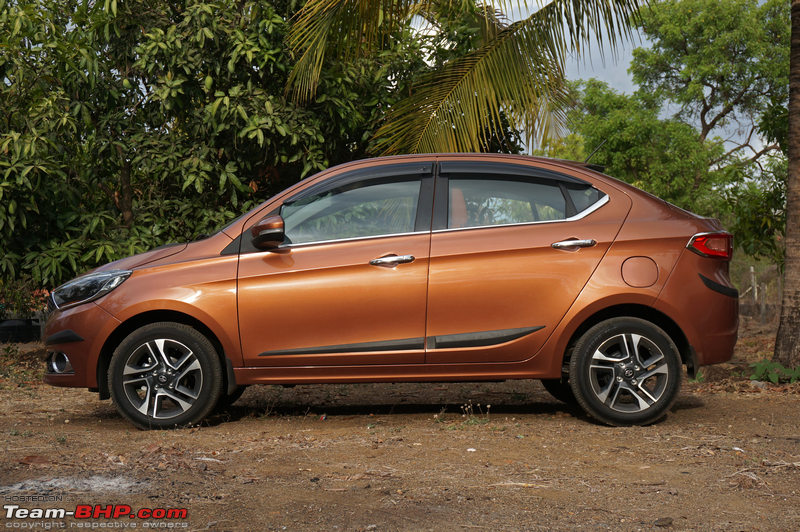 Overall build quality is solid. Doesn't seem flimsy at all:  A lot of interesting design elements on the car and you can tell the amount of work Tata has put in to get away from its old design philosophy. The Tigor is available in the same paint schemes as the Tiago, except the Sunburst Orange of the Tiago has been replaced with this Copper Dazzle shade: 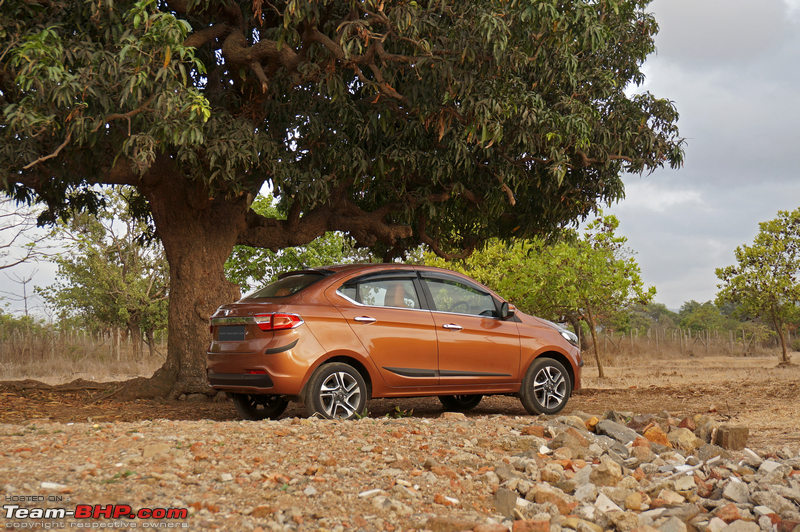 Sharp character lines! Check out the line running from the edge of the headlamp and integrating with the window line. The line starting from the fender continues over the doors… 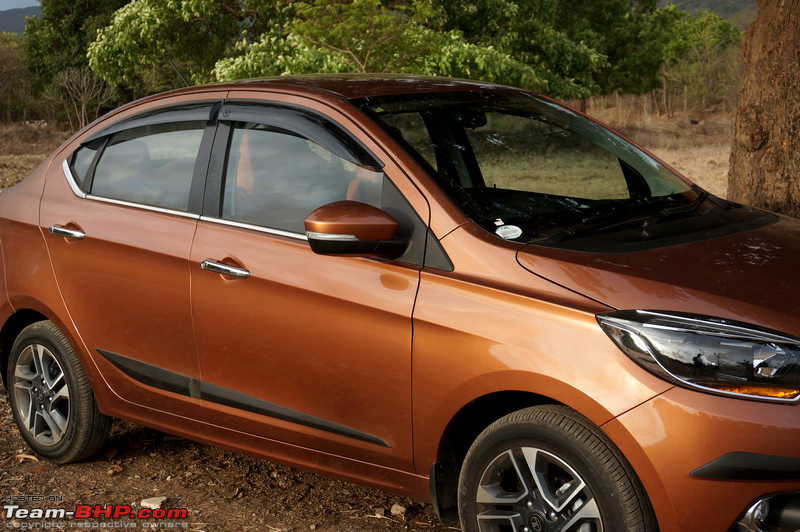 …and integrates with the tail lamp. These character lines are the reason for the slight increase in the width of the Tigor as compared to the Tiago: 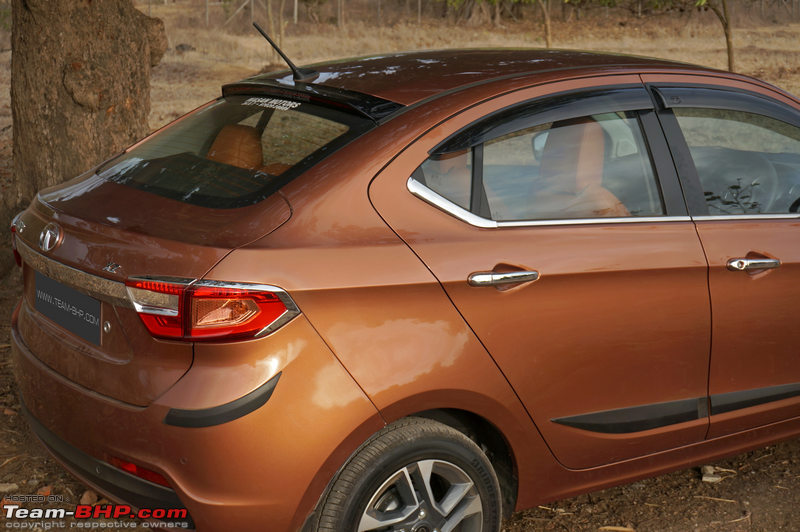 A single projector headlamp in a dual barrel setup. In terms of size, these are similar to the Tiago. Tigor headlamps get a smoked effect: 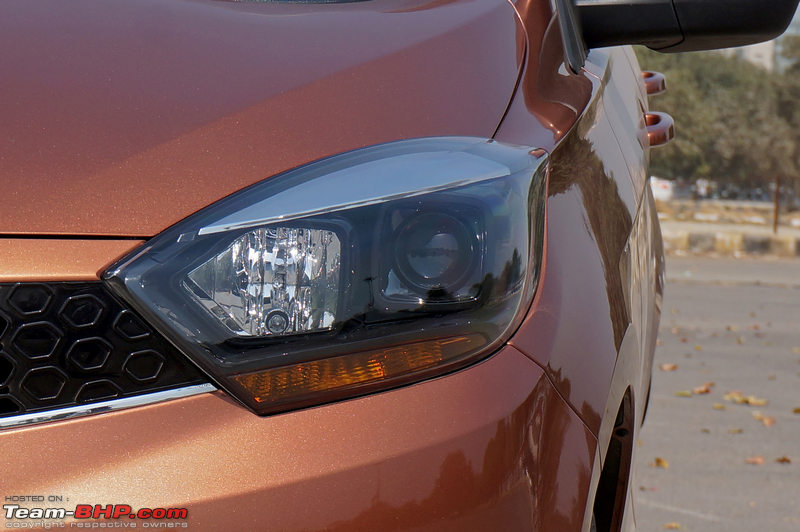 The projector isn't LED (like the Dzire), and there are no DRLs either. A chrome strip is placed inside the headlamp above the two barrels. The chrome garnish outside the headlamp is an added accessory: 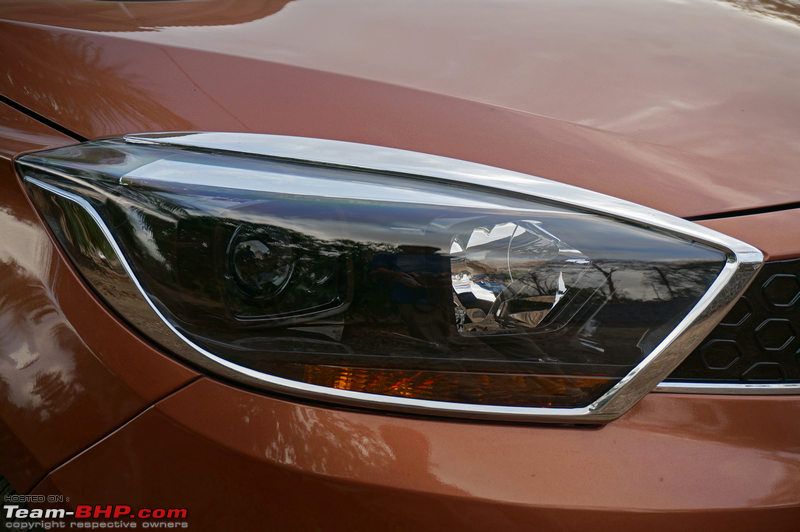 With all the lights in action. The turn indicator is placed at the bottom and the headlamp unit does its job well in lighting up the road: 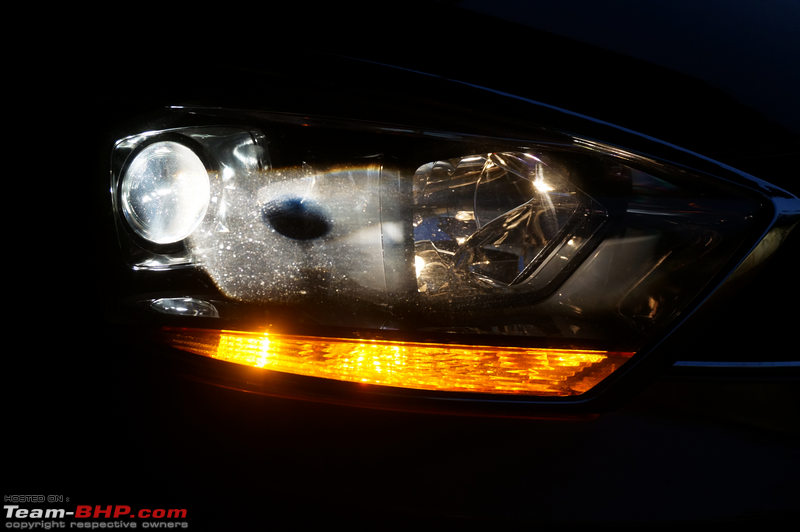 Gloss / piano black grill with the humanity line (chrome underlining on the grill that joins the headlamps). The honeycomb pattern & the holes becoming progressively smaller toward the sides was something we'd seen on the Tiago, but… 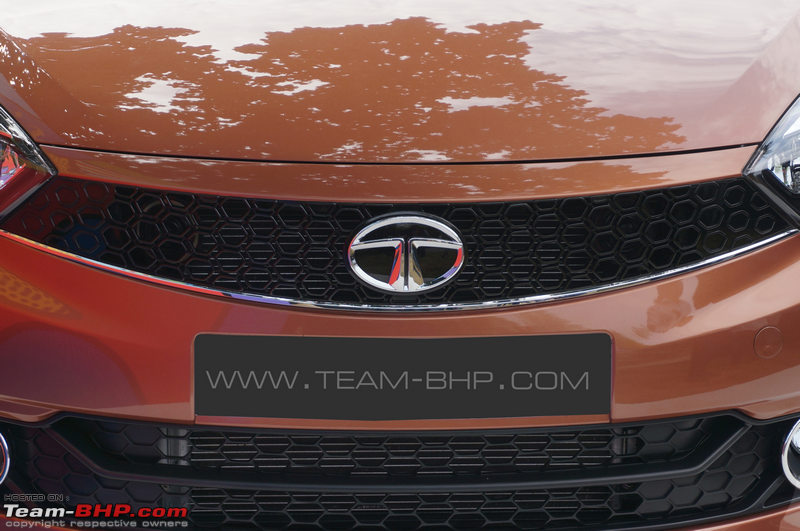 …if you look carefully, the structure has changed. The hexagons are connected by lines instead of solid piano black: 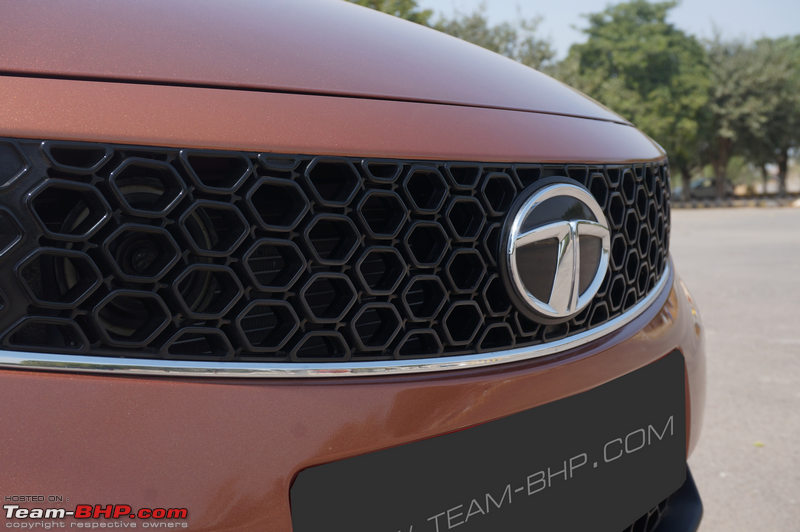 The hexagons make it to the air-dam as well. The tow hook is placed on the left of the car, and the dimple on the cover shows you where you have to press it. See the black strips above the fog lamps? They're available as an accessory: 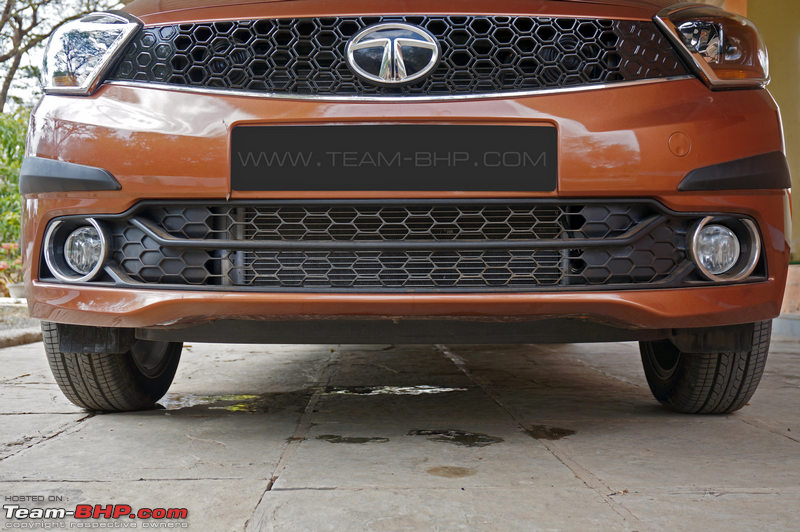 Foglamps with chrome surrounds look neat: 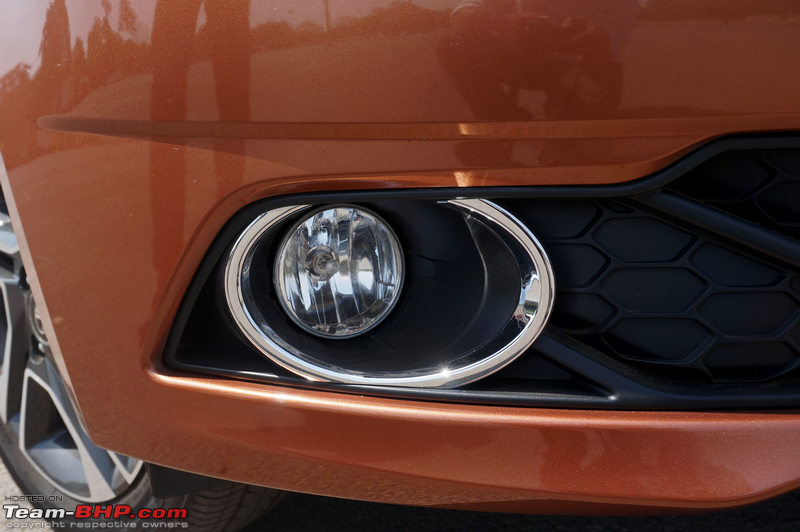 Considering Indian conditions, some underbody protection should have been provided. Note the lower wishbone of the suspension on both sides: 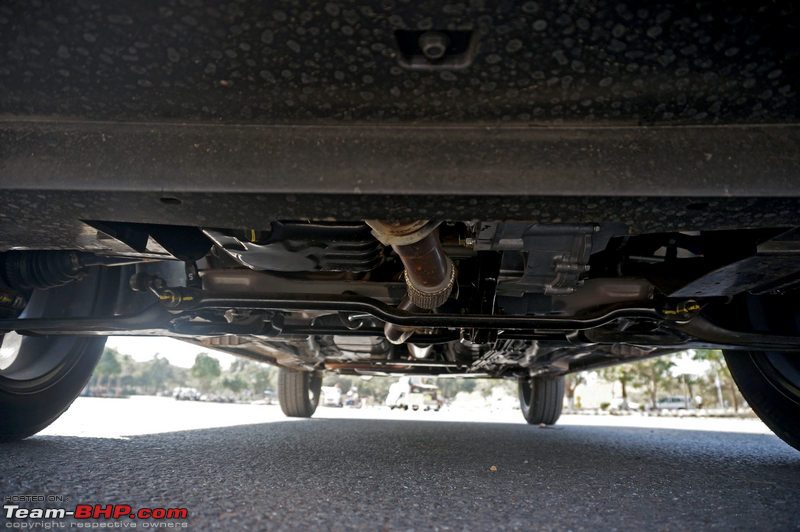 The wipers are placed low - outside the driver's field of vision (from inside). Notice the smart hexagonal detailing. The washers are located on the black plastic wiper console:  The two creases on the bonnet continue towards the A-pillar: 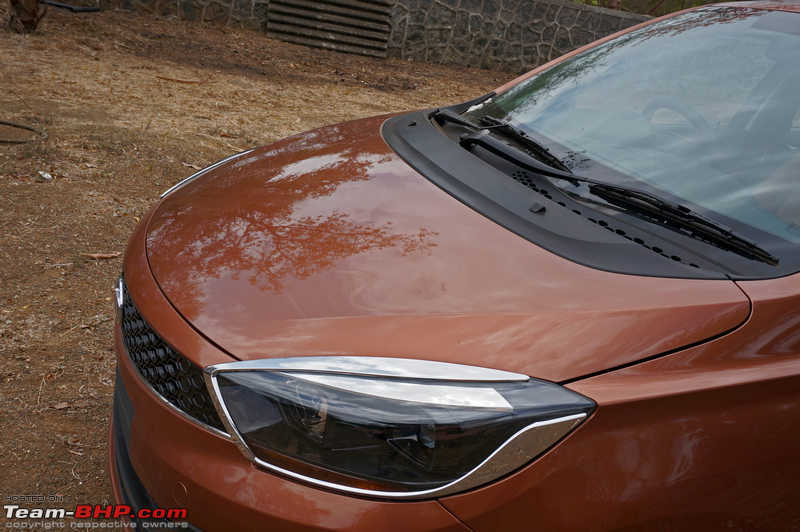 Smart-looking ORVMs with integrated LED turn indicators: 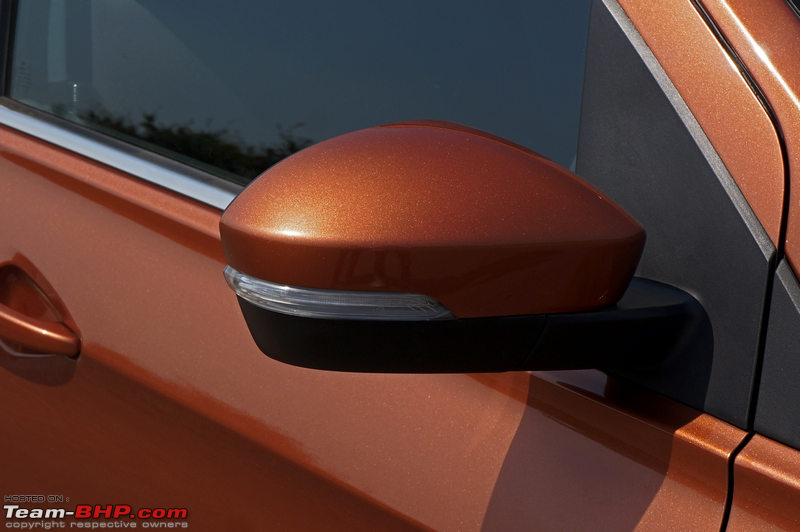 15-inch alloy wheels look pretty cool! These are shod with 175/60 R15 Bridgestone tyres. One thing to note is that these 15-inch alloys are available only on the top end XZ and XZ (O) Petrol variants of the Tigor: 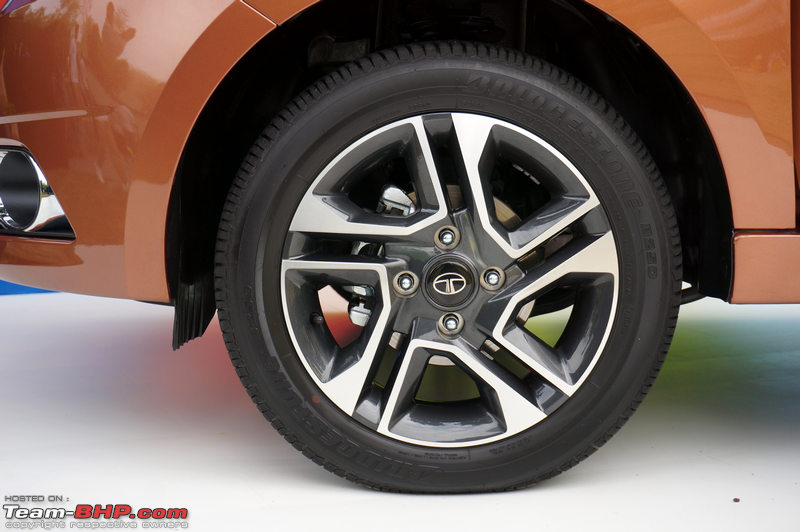 For the top-end Diesel variants, you will get these comparatively boring 14-inch alloys with 175/65 R14 profile tyres. These are similar to the ones on the Tiago (reference image): 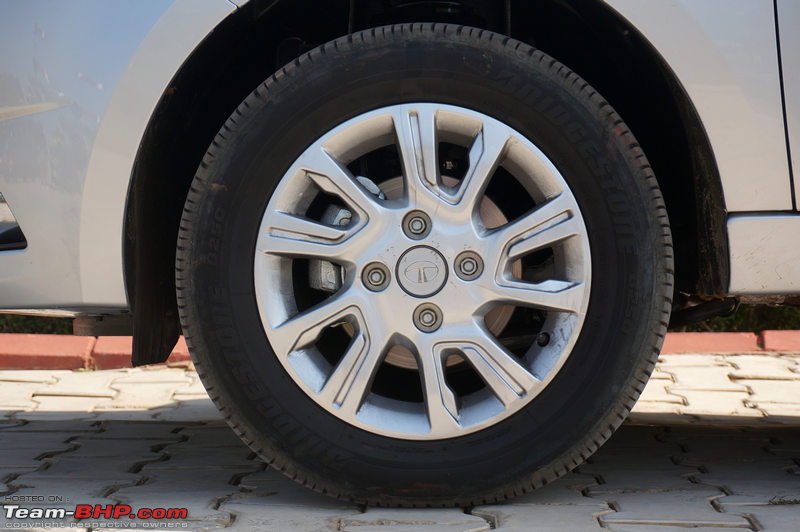 Both, front & rear tyres get aero flaps ahead of them: 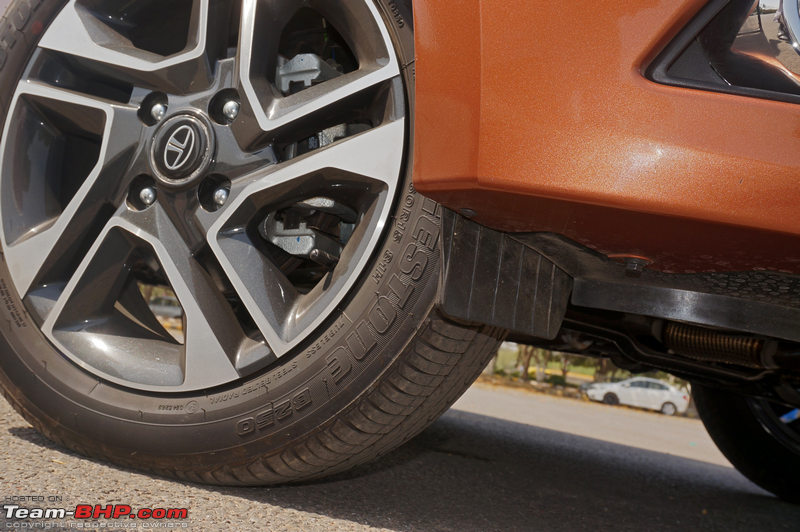 Healthy amount of wheel well cladding at the front, with partial cladding at the rear:  Body coloured door handles available on all variants except the base. The chrome is an additional accessory. Sharp-looking arrow-shape door handle design is carried forward from the Tiago: 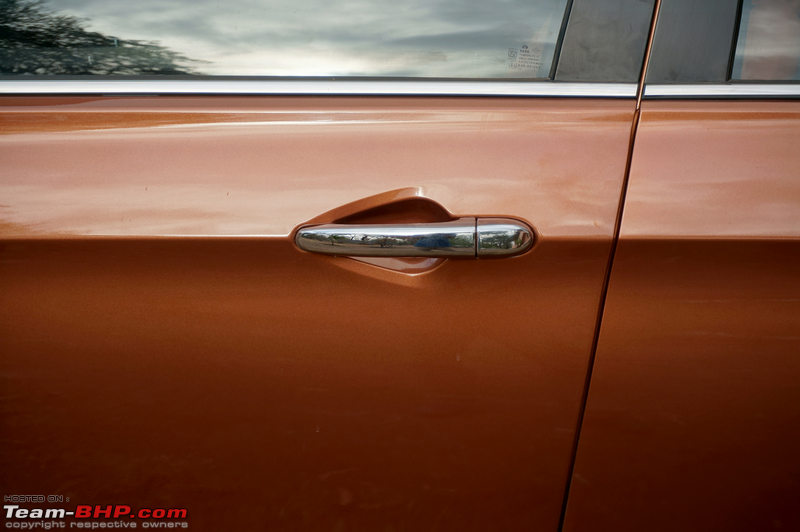 Despite having double-layered insulation, wind noise still creeps in at highway speeds: 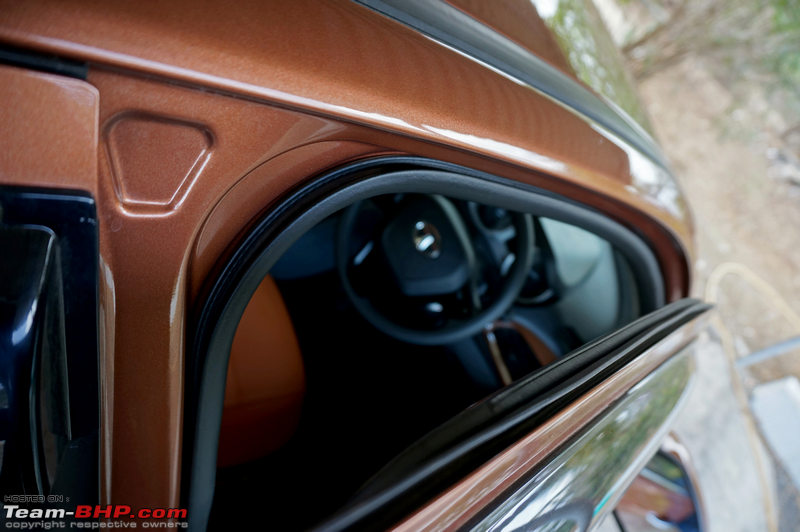 Blackened B-pillars. Notice the chrome window line running parallel to the waist line. It's not an accessory and is available on the top-end XZ variant: 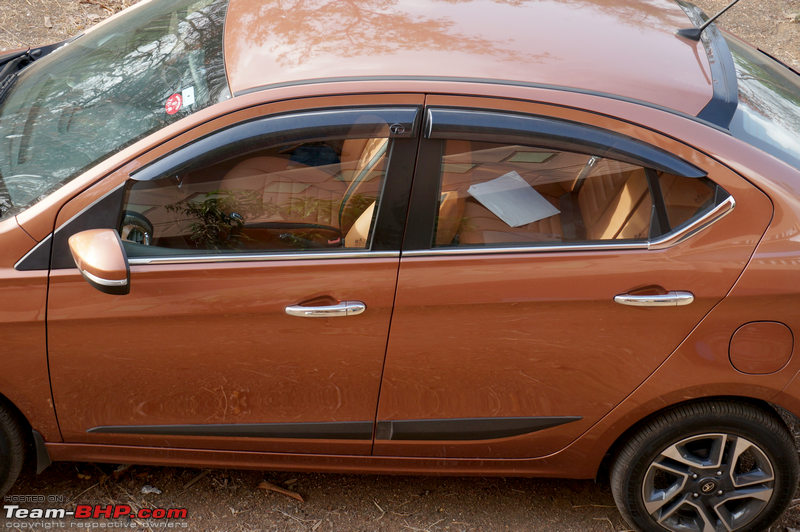 Quarter glass has been added to the rear doors: 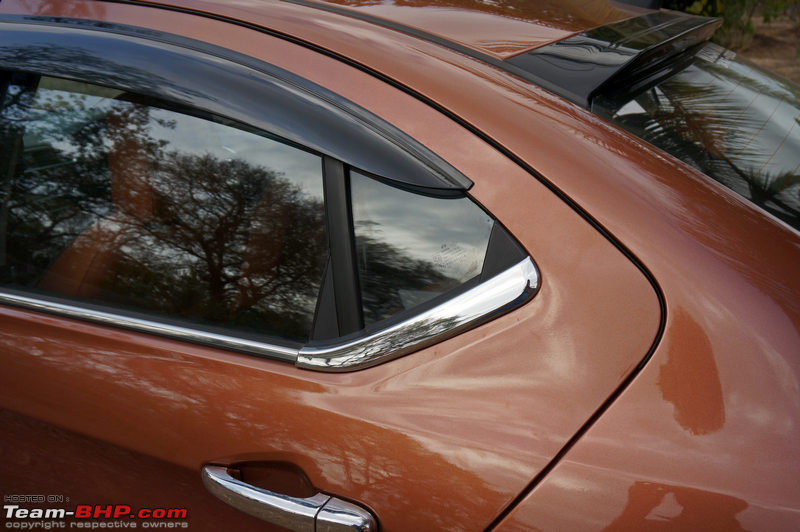 Smooth integration of the boot along the C-pillar. Also note the horizontal defogger lines instead of the maze on the Tiago: 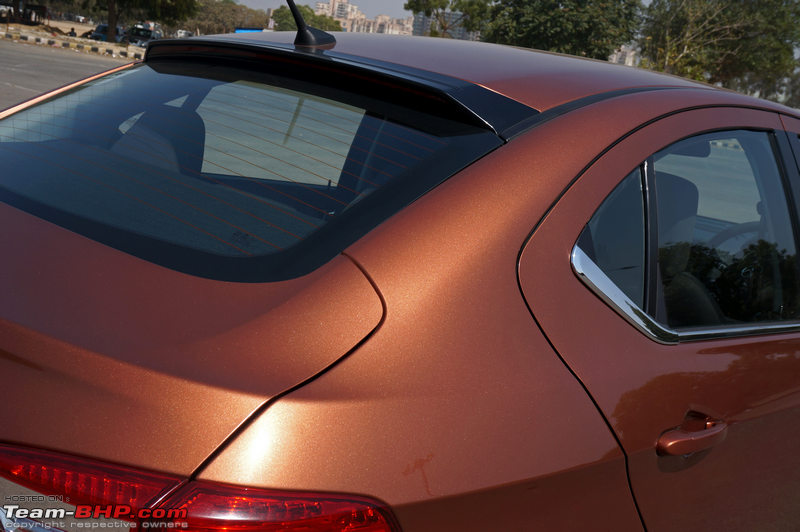 The rear bumper slightly juts out at the bottom. Might prove to be of some advantage if you are rear ended, but the limited protection is just like any other compact sedan: 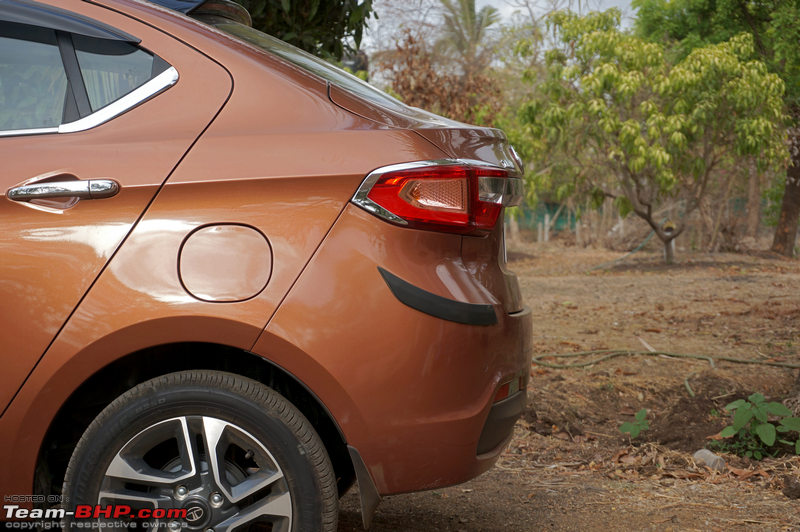 Protrusion in the rear wheel well acts as a splash guard. This was integrated into the bumper in the Tiago (reference image): 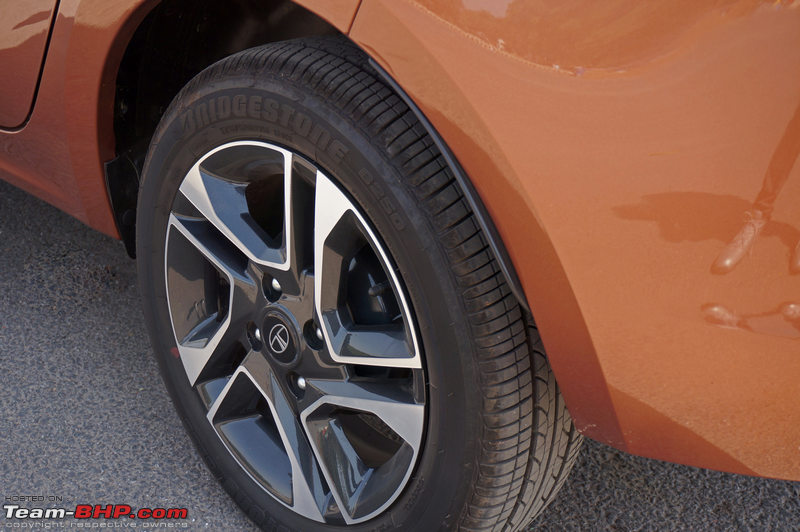 The roof is raised in the middle at the back. It is aimed to increase the headroom at the rear, and also houses the HMSL: 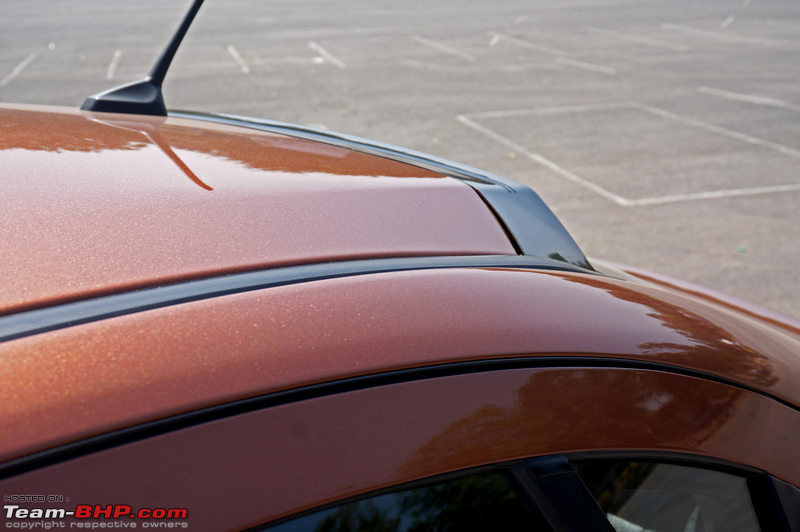 The wide LED HMSL which is standard across all variants surely grabs some eyeballs on the road: 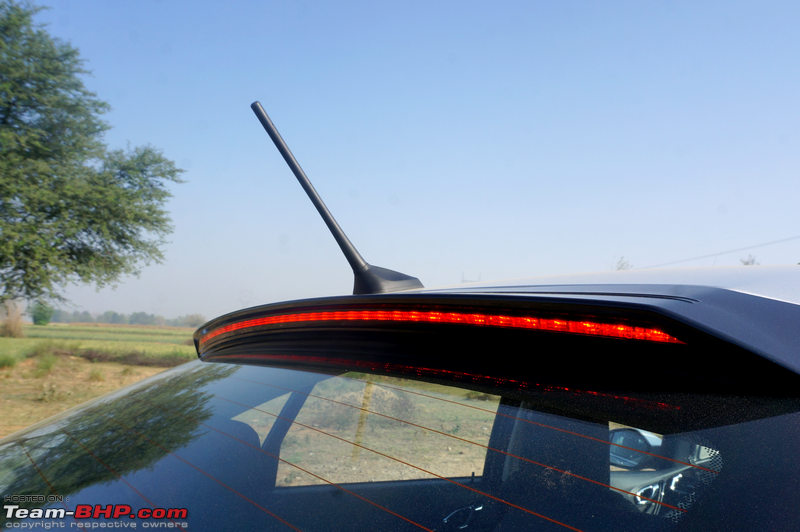 Roof antenna has been placed at the end of the roof, just ahead of the HMSL: 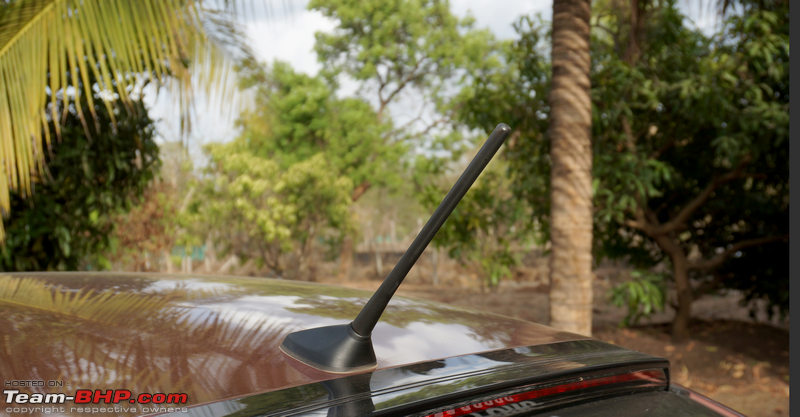 A split tail lamp unit is a segment first. The part below the turn indicator is LED and acts as a parking lamp, while the part above the turn indicator is a stop lamp: 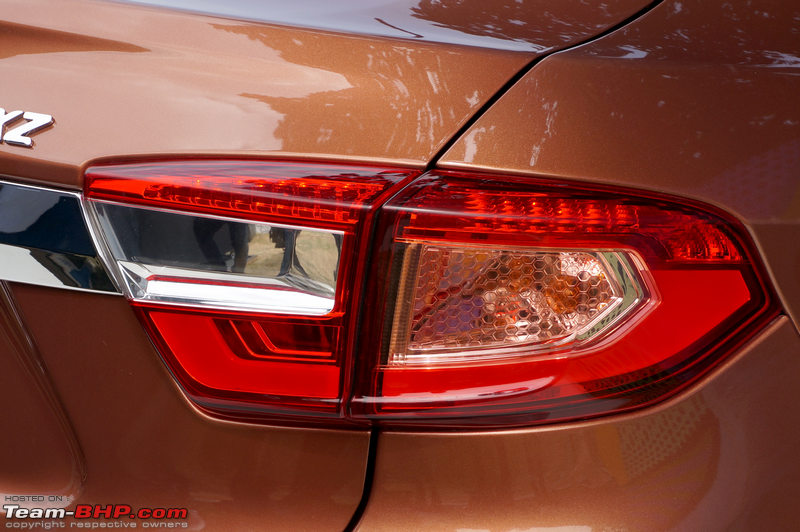 The chrome strip actually runs into the tail lamp unit (Jaguar touch?). The part above the chrome strip is a safety reflector: 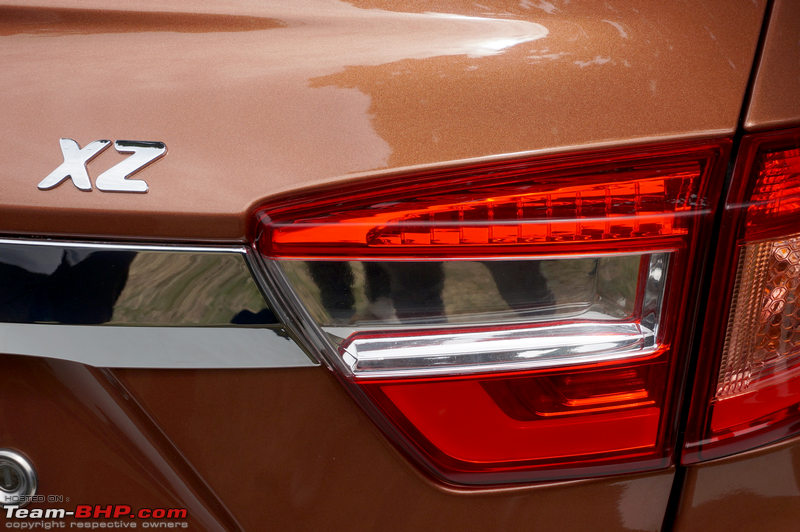 LED strip looks sweet: 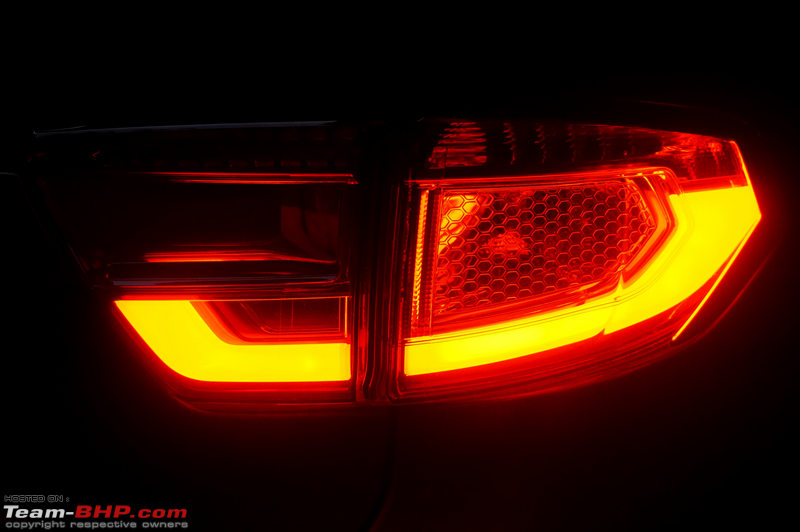 Reversing camera is placed on the thick chrome strip of the boot lid: 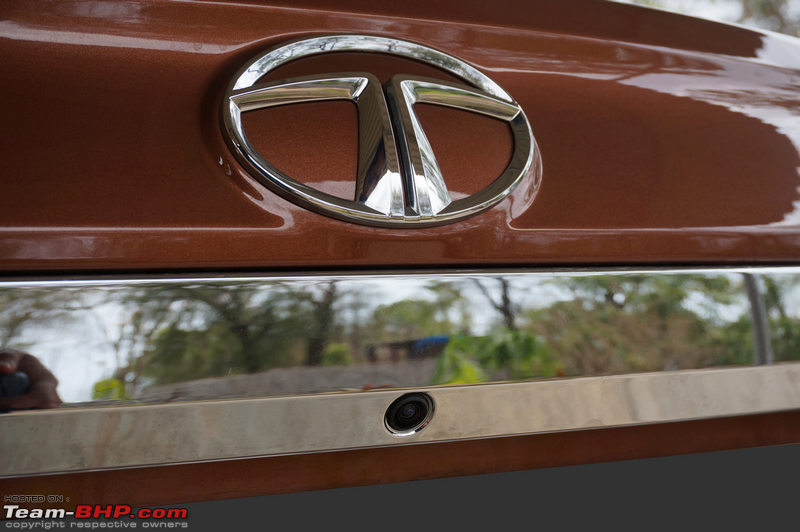 The Tigor badge on the left… 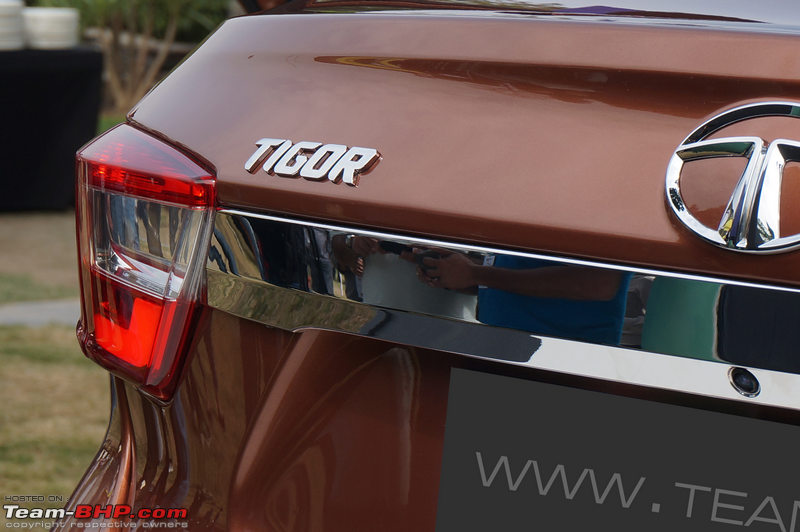 …and variant badging on the right. There's no engine badging anywhere on the car: 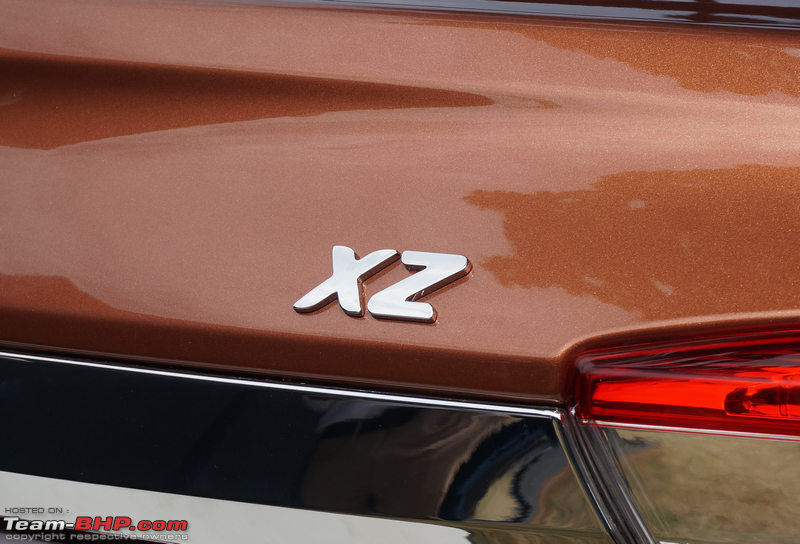 Check out the position of the parking sensors at different levels. The Tiago had all the parking sensors on a single level. The rear bumper houses two safety reflectors. The one on the right is accompanied by a foglamp: 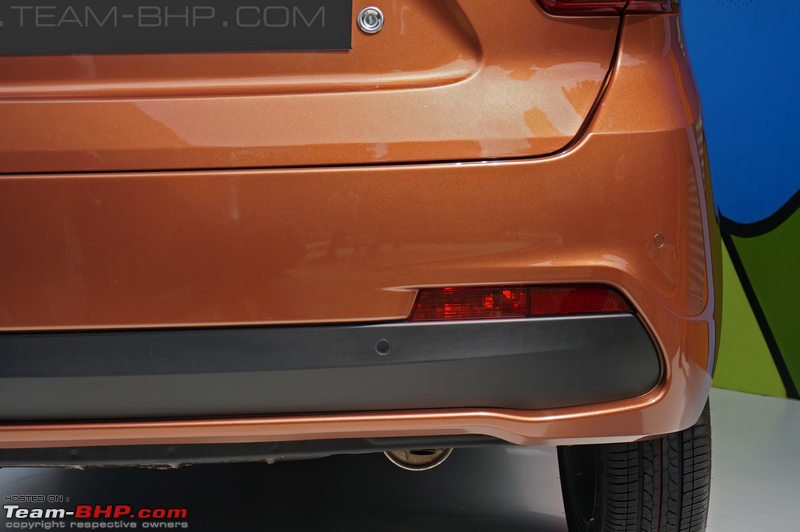 A single reversing lamp (sadly) is accompanied by a safety reflector on the side: 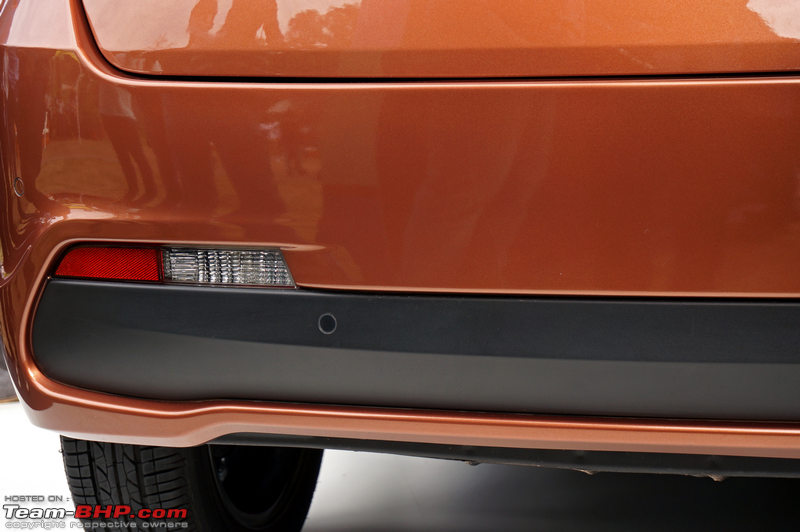 Ground clearance in unladen conditions is 165 mm with 13-inch wheels and 170 mm with 14 + 15 inch wheels. Don't miss the 'Kite 5' scribbling: 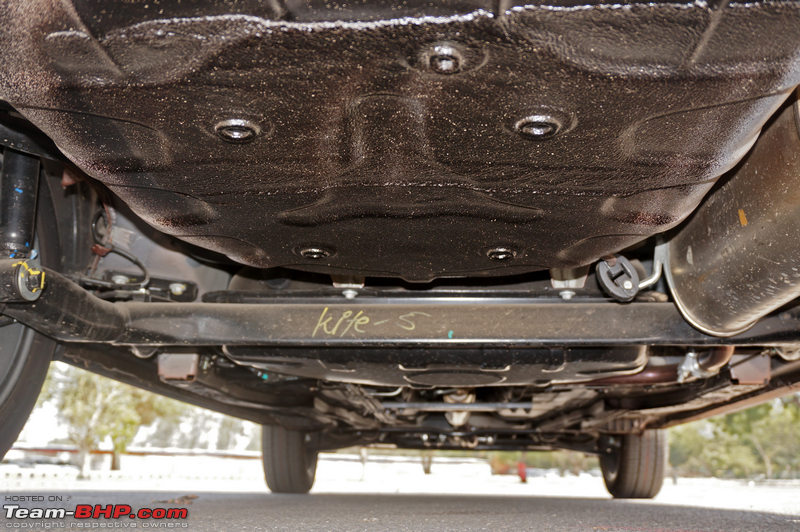 Face to face with its hatchback sibling. The Tiago's shorter wheelbase clearly visible in the picture. The bigger alloys give the Tigor a slightly raised stance: 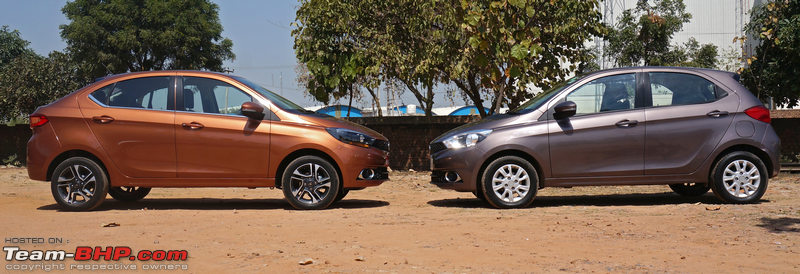 Last edited by tsk1979 : 25th June 2017 at 12:22. Reason: Platform edit |
| |  (43)
Thanks (43)
Thanks
 |
| The following 43 BHPians Thank Omkar for this useful post: | amit_purohit20, AutoIndian, Avikbrio, AYP, CarguyNish, carrazy, dailydriver, Flyer, grkonweb, GTO, hemanth.anand, InControl, Ironhide, Jakku, Karthik Chandra, LoneRidder, MDED, mrbaddy, Nohonking, phoenixash, phynix123, Ponbaarathi, PraNeel, RavenAvi, red.devil_19, Reinhard, S.MJet, samabhi, shipnil, SmartCat, SnS_12, sri2012, sukiwa, sunny29584, swiftnfurious, theexperthand, theredliner, vaish9925, vb-saan, VeluM, vibbs, vishy76, vsrivatsa |
| | #4 |
| Team-BHP Support  Join Date: Apr 2016 Location: Mumbai
Posts: 2,408
Thanked: 25,654 Times
| Interior - Front Getting in and out of the Tigor isn't very easy since the car is slightly low - be sure to watch your head. The overall layout and the structure of the dashboard is the same as the Tiago. The black and grey colour scheme has also been carried forward, though the grey is a little darker now. IMO this gives the cabin a gloomier feel and I would have preferred the slightly lighter shade of grey in contrast with the black. The quality of materials used however is good and the parts seem to be screwed together quite well. There are small changes throughout the cabin as compared to the Tiago like the addition of soft fabric on the door armrest, addition of an extra 12V power socket, rear centre armrest etc. The most visible difference in the interiors would be the addition of a 5-inch touchscreen unit: 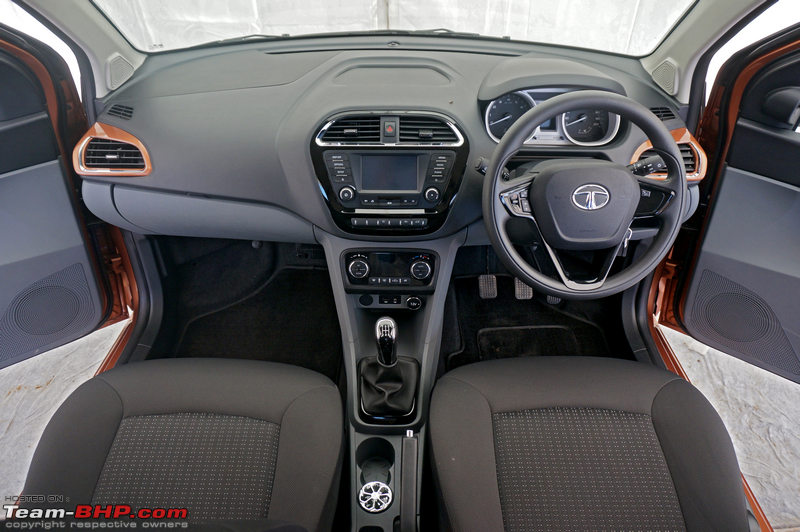 Overall view from the driver's seat is satisfactory:  Steering wheel is a direct lift from the Bolt and Tiago. Small in diameter, good to hold. Nope, no leather wrapping here: 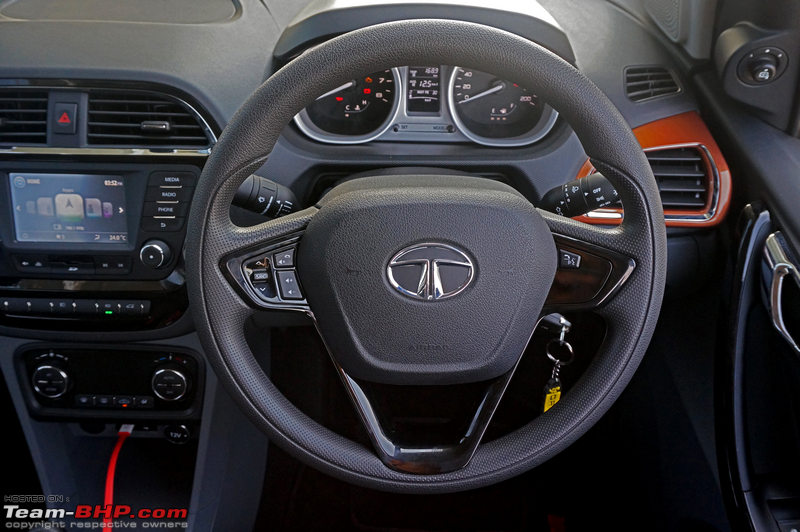 Tilt adjustment has a healthy range:  Audio & phone controls on the steering wheel. Useful mute button as well. Voice command button from the Zest is there (on the right). The voice command system isn't as sophisticated as some of the high-end cars, though it's good to have this feature in the car. These buttons don't give the tactile feedback we'd have liked:  Instrument console is on the smaller side, just like the steering wheel. The petrol & diesel cars get an identical revv counter (cost cutting). Always nice to see a temperature gauge which has gone missing in so many new cars. The tachometer needle doesn't turn red as it approaches the redline like it did in the Tiago:  A look at the well-sculpted cowl above the instrument console: 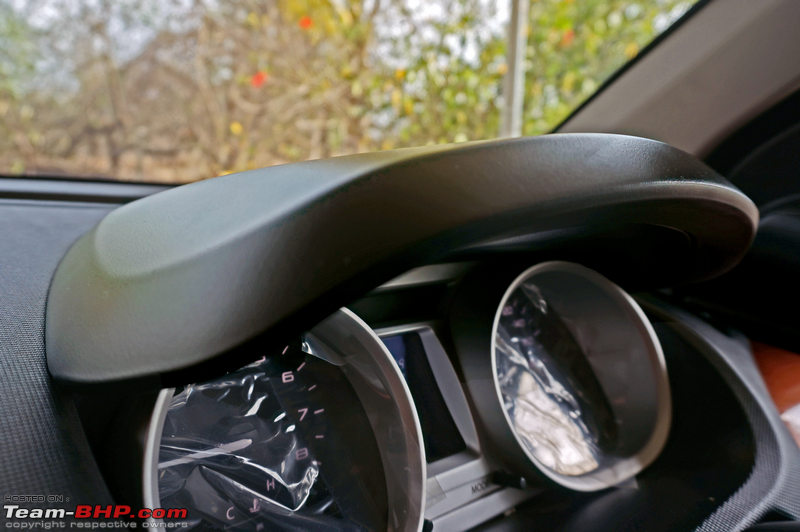 ECO and CITY drive modes backlit in green and blue respectively:  MID layout is slightly different than the Tiago. Displays tank range, average fuel consumption, time, outside temperature and 2 trip meters. A gauge at the bottom shows you the real-time fuel economy (easier to read on the go than a constantly changing number). MID also points out exactly which door is open. You can adjust the time by long pressing the SET button. To adjust the illumination, turn the Park lamps on and then long press the SET button:  Top left shows you which door is open and the right pic shows the current gear position. One thing to note is that the current gear position disappears as soon as the clutch is pressed, appearing only when the clutch is completely released:  Thick stalks feel durable. No complaints here. Intermittent wiper delay is adjustable. Headlamp leveler is on the stalk itself. The dummy buttons are present on the side like in the Tiago (reference image):  Illuminated key ring. It takes some effort to slot the key inside. Doesn't go in smoothly:  Owners of the Bronze & Red Tigor can opt for body-coloured side air-con surrounds:  Driver-side cubby is fairly deep. The base is slightly lowered in order to hold coins:  Black section of the doorpads (and dashboard) wears top quality plastic. Wow, just look at how the window line slopes downward! The grey colour scheme is slightly darker than in the Tiago:  Chrome door handles look nice (they're plastic, not metal):  Rotary ORVM adjuster:  All window switches are backlit  . The driver's window gets one-touch down: . The driver's window gets one-touch down: Fabric insert on the doorpad and elbow rest. Tiago had plastic here: 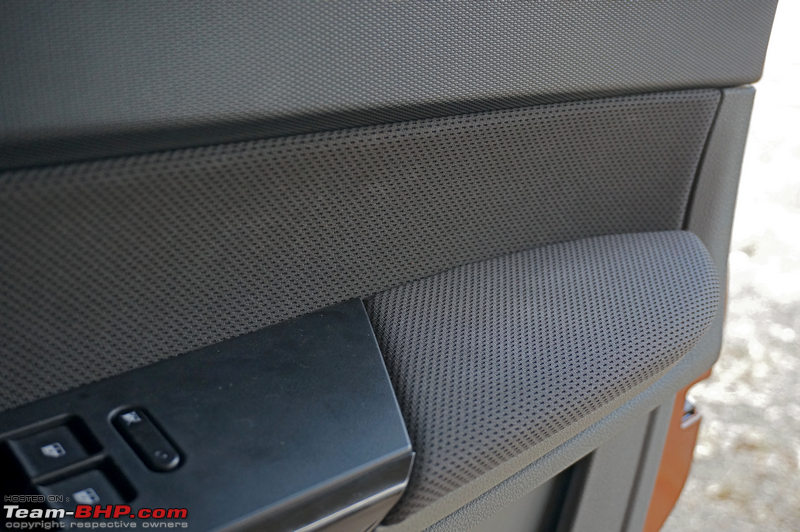 Door pockets can hold two 500 ml bottles easily, with a little space left over for the knick-knacks:  Yikes, Maruti Alto'ish pull-type door locks are so out of place in an otherwise nice interior. Tata said the door handle design couldn't accommodate the integrated locking knobs we see on modern cars. You'll be using these ugly knobs a lot as there's no dedicated central lock / unlock button:  The driver's seat can be adjusted for height and it offers a healthy range too. The passenger seat is fixed at the highest seating position, thus if the driver's seat is positioned low, the front passenger can literally watch over the driver. The front seats offer good support, both - lateral as well as under-thigh, for a person of a medium build and height. Even the seat cushion is on the softer side and you tend to sink into them. It must be mentioned that soft seats aren't supportive over long distances. Dark colour = practicality:  The headrests of this car are adjustable, even though they look like they're integrated into the seat:  Full-size fore & aft adjustment lever:  Driver's seat gets a healthy range of height adjustment: 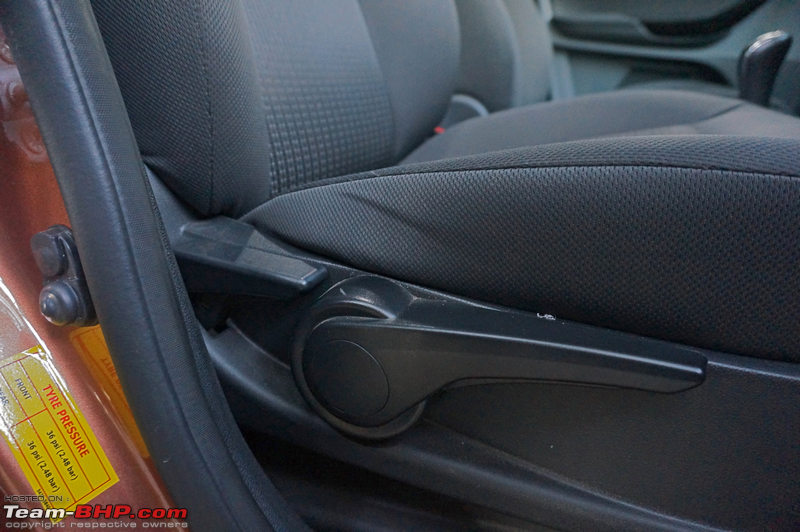 The seatbelts aren't height adjustable which is a segment norm of sorts:  A-B-C pedals and one to rest your left foot. Dead pedal is positioned a little too high for comfort though:  The fuel flap opener is placed on the floor. Notice the Tigor-badged floor mats:  The bonnet release lever is placed on the right-hand side of the driver (below the dashboard). Looks like an after-thought; should have been better integrated:  The hexagonal ORVMs are adequately sized (height and width, both):  No complaints with the IRVM either. It has a manual day / night adjuster:  Rearward visibility isn't satisfactory. Fixed headrests and thick C-pillars don't help either:  The centre console is slightly tilted towards the driver:  Piano black inserts & chrome touches look very tasteful. Typically classy Tata. None of the air vents can be shut off completely:  The ECO driving mode, front foglamp and boot release buttons are placed here. The three dummy buttons do look out of place:  A feature addition over the Tiago is 'climate control'. The unit is similar to what we'd seen on the Bolt. We found the petrol's air con to be super effective and never felt the need to go beyond blower speed 1. Even at that speed, the blower is audible, but manageable. It gets louder till 3 and is absolutely annoying from 4 through 7. Me and Eddy also found the diesel's unit to be noticeably weaker (S2!!! and Vid6639 had made the same observation on the Tiago as well). The left knob controls the blower speed, while the right knob sets the cabin temperature. The ECON button when activated cuts off the compressor at a slightly higher temperature than the normal AC - useful when you are aiming for better fuel economy. The empty space in between the knobs looks bizarre, you'd expect a climate control readout:  12V power socket with USB & AUX ports. That's a dummy one on the left. Note that the cover for the 12V power socket is from the Hexa (not the Bolt or Tiago). There's enough place below to park a large 'phablet':  Nice looking gear lever is borrowed from the Bolt / Zest:  The handbrake is positioned closer to the driver. The placement releases space for 3 differently-sized cup holders and a small cubby. Behind that cubby is another 12V power socket (Tiago didn't have this):  A premium feature in this budget hatchback - soft opening / closing glovebox lid!!! Push button to open the glovebox à la Jaguars: 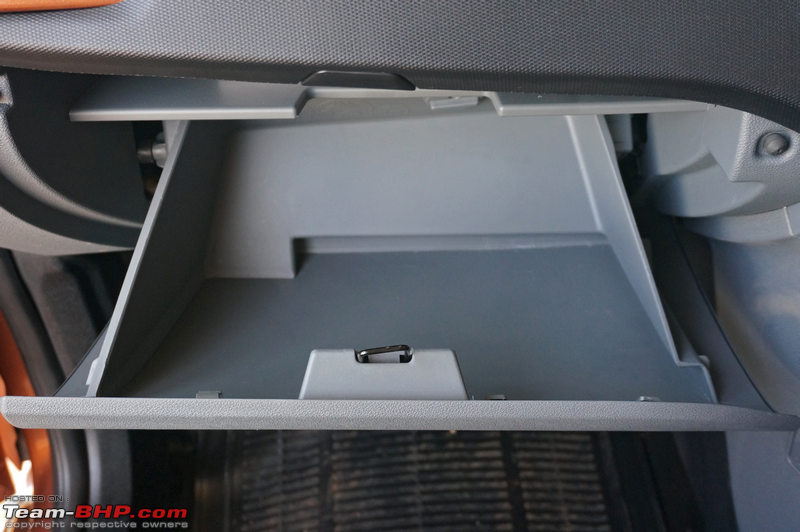 Glovebox size is sufficient. Partition on top can hold a tablet:  Cooling vent in the glovebox. Notice the elephant design here. Male, female & baby elephant portray that the Tigor is a family sedan? Tata says 'it’s a gesture towards the endangered Indian animals and part of the IMPACT design philosophy to have a lasting impact over time. It is something not all owners might even realize until they look very closely in the glovebox, and a small detail that we hope the consumer discovers in his / her ownership experience of the car':  Super useful bag hook in the passenger footwell (capacity of 2 kilos):  Spring loaded grab handle for the passenger seat:  White LED cabin light with a theatre-dimming effect. If there's only one cabin lamp, it's best placed here (in the roof's center) and not at the front:  Attention to detail = Bluetooth mic carries forward the same design as the speakers. Fabric roof liner's quality is premium: 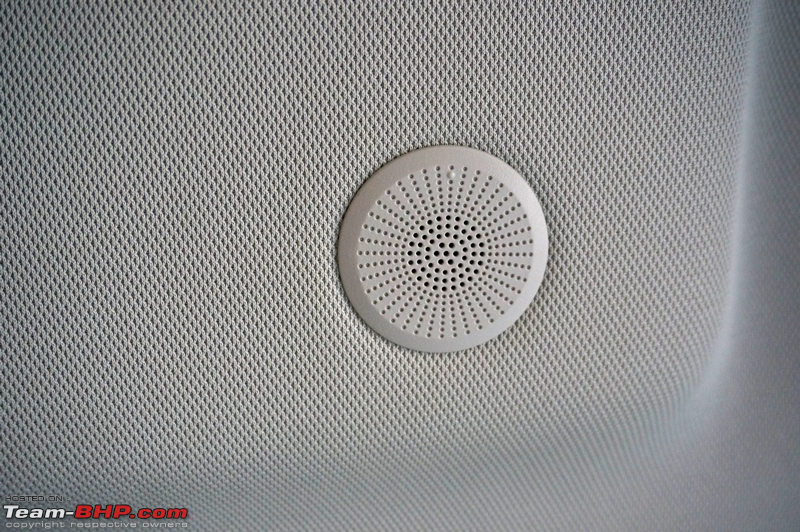 Nifty clip to hold tickets & slips on the windscreen. We'd first seen it in the Skoda Yeti (link to image): 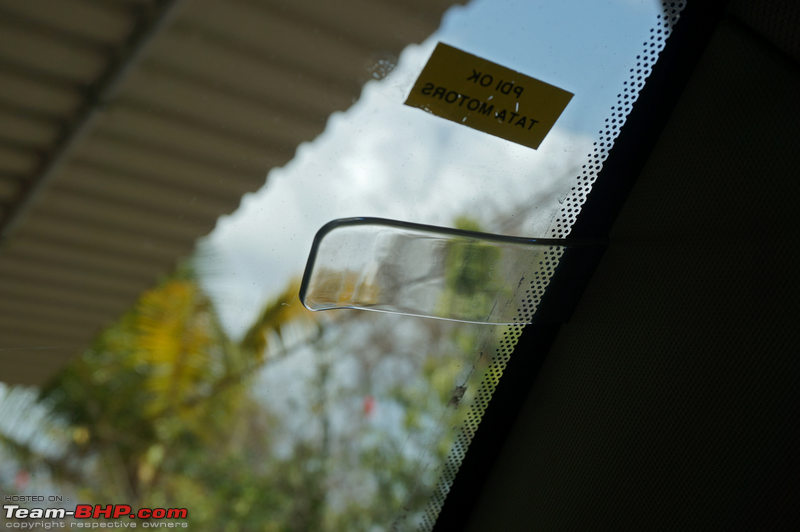 Dual airbags only on the top end variant  . Nearly all competitors are offering these as standard, across all variants (including the 2017 Dzire): . Nearly all competitors are offering these as standard, across all variants (including the 2017 Dzire): Flippy key is shared with the Bolt & Zest. Long pressing the 'follow me lights' button opens the boot:  Lower variants get a regular key: 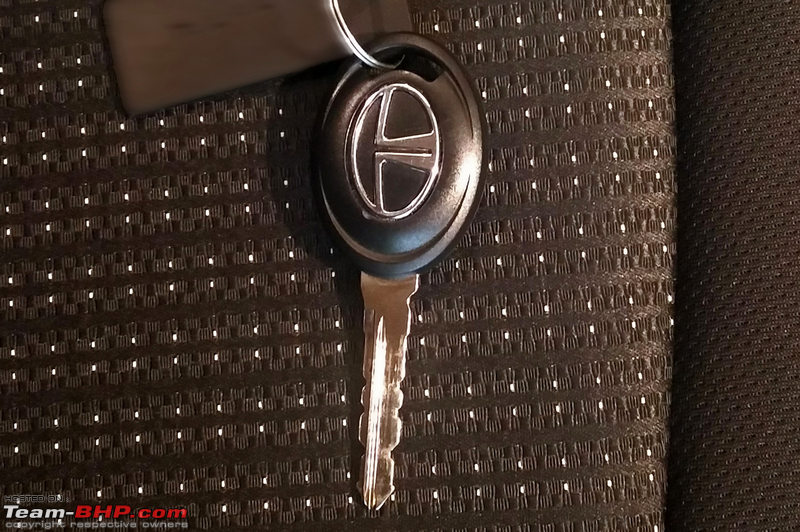 Last edited by GTO : 26th June 2017 at 12:38. Reason: Typo |
| |  (38)
Thanks (38)
Thanks
 |
| The following 38 BHPians Thank Omkar for this useful post: | amit_purohit20, Ani0404, AutoIndian, Avikbrio, AYP, blackwasp, CarguyNish, carrazy, dailydriver, GTO, hemanth.anand, InControl, Ironhide, Jakku, Karthik Chandra, LoneRidder, MDED, Nohonking, phoenixash, phynix123, Ponbaarathi, PraNeel, Rajeevraj, RavenAvi, red.devil_19, rj22, S.MJet, samabhi, shipnil, SmartCat, SnS_12, sunny29584, swiftnfurious, theexperthand, theredliner, vaish9925, vb-saan, VeluM |
| | #5 |
| Team-BHP Support  Join Date: Apr 2016 Location: Mumbai
Posts: 2,408
Thanked: 25,654 Times
| Interior - Rear The doors open wide. Ingress and egress however aren't great - the sloping roofline and low seating means that you have to duck into the cabin & watch your head while sitting:  Look at the sharp angle of the door. The first time I opened the rear door, the sharp edge of the door hit against my chest. This is probably due to the placement of the rear door handle. The distance between the edge of the door and door handle is much more than usual. Moderator Eddy had the contents of his shirt pocket knocked out when he first tried opening the door!  The window line moves up towards the end, and unlike the front doors, there is no piano black finishing here:  Wide door sill:  Plastic chrome door handle at the back. Rear passengers get tweeters too! This is in addition to the speaker below:  Fabric inserts make it to the rear doorpad as well. This is a nice touch; though not very soft, it is definitely better than the plastic on the Tiago. The power window switches are backlit:  Rear passengers get a 1L bottle holder in the door pockets:  A look at the rear bench. The seats are well-contoured and soft like the front seats. The increase in wheelbase has reflected in the legroom - it's very healthy. The backrest angle is also slightly more relaxed as compared to the Tiago:  Seat bolstering extends till the edge and will hold passengers in place. The rear seat can accommodate 3 passengers (though it's best for 2):  With the front seat adjusted to my height of 5'10", I had enough legroom. The recline angle is comfortable and the under-thigh support is also satisfactory. This is a good backseat:  Approximately 2 inches of spare headroom for me. It's sufficient for most, except the 6+ footers:  Maximum and minimum legroom shown in this image:  Another angle showing the max & min legroom. Note the missing seatback pockets. They are useful storage solutions & shouldn't have been skipped by Tata:  Although the headrests are fixed, they are quite tall and provide decent comfort. All other cars in the segment (except the Honda Amaze) provide height-adjustable neck restraints:  Middle passenger also gets this small headrest:  The rear centre armrest is soft & comfortable to use. The height is slightly more than I would have liked:  The integrated cupholders have a rubber edge to hold cups in place & prevent shake. With the addition of these two, the total count of utility spots in the Tigor has gone up to 24 (Tiago had 22):  A deep storage area at the end of the handbrake console for rear occupants:  Parcel tray has a good border - won't let objects slide ahead easily:  The floor hump is on the taller side. Middle passenger won't be happy:  A slight indentation on the roof where the antenna is mounted:  The seatbelts are integrated into the C-pillar and directed through the parcel tray:  Middle passenger gets a lap belt:  Quality of the spring-loaded grab handles is nice. One on the right side gets a coat hook:  The rear window rolls down *almost* all the way. Slightly up at the front edge:  At 419 litres, the Tigor has the biggest boot amongst the competition!! The initial design criteria was to provide a wide opening for the boot, which led to the splitting tail-lamps. Though the opening is wide, it is a bit short on height and the loading lip is quite high. Rear seat does not fold down (like most of the competition):  Tata has gone with a 4-bar mechanism. It also gets pneumatic struts to ease the opening action. The mechanism is actually a better option over the conventional gooseneck hinges which interfere with boot space (related thread):  A look at the operation of the mechanism: 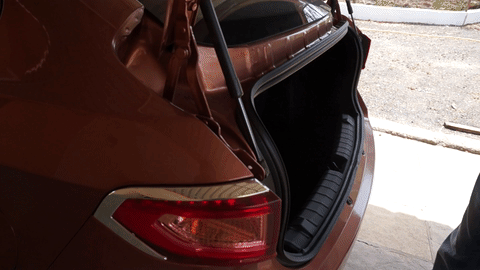 To open, press the electric boot release button on the centre console. Note that the car should be in ignition ON condition to operate that button. Another way to open the boot is to long press the follow me headlamp button on the key fob for about 4 seconds till the red light on the key fob blinks. All the indicator lights blink once when the boot is unlocked. They'll blink twice when you shut the boot. The boot lid is light to operate and makes a tinny sound when shut:  None of the other cars in the segment (Xcent, Amaze, Aspire, Ameo, Zest) get cladding in the boot. Even the new Dzire has a naked boot lid. Furthermore, all cables and the boot opening mechanism are well hidden  . The Tigor simply doesn't have that cost-cutting feeling that some of its competitors do. Pat on the back, Tata: . The Tigor simply doesn't have that cost-cutting feeling that some of its competitors do. Pat on the back, Tata: The boot gets a lamp, though the underside doesn't look pleasant at all. There is no proper paint coating and these sharp plastic screws jut out from the top (may damage soft bags). The exposed wire for the boot lamp is such an eyesore:  Warning triangle is parked in a pocket behind the seat:  The spare is a full size steel wheel:  The tools are arranged nicely in Styrofoam like the Honda Amaze:  All the wiring is tucked out of sight. It's nice to see Tata care about these little things. Shows effort to do things right:  Last edited by GTO : 25th June 2017 at 10:51. |
| |  (38)
Thanks (38)
Thanks
 |
| The following 38 BHPians Thank Omkar for this useful post: | amit_purohit20, Ani0404, AutoIndian, Avikbrio, blackwasp, CarguyNish, carrazy, dailydriver, dark.knight, GTO, hemanth.anand, InControl, Ironhide, Karthik Chandra, LoneRidder, MDED, Night_Fury, nmenon, Nohonking, phoenixash, phynix123, Ponbaarathi, PraNeel, RavenAvi, red.devil_19, S.MJet, samabhi, SmartCat, SnS_12, sukiwa, sunny29584, swiftnfurious, theexperthand, theredliner, vaish9925, vb-saan, VeluM, vsrivatsa |
| | #6 |
| Team-BHP Support  Join Date: Apr 2016 Location: Mumbai
Posts: 2,408
Thanked: 25,654 Times
| In-Car Entertainment The top-end XZ (O) variant gets this 5-inch touchscreen unit developed by Harman. In terms of RMS power, this system is more powerful than the Tiago's. While the Tiago uses a 20W RMS x 4 in-built amp, the Tigor uses a 25 W RMS x 4 unit. This is a more capable unit and has a DSP (digital signal processor) audio processor. This allows you to play around with the equalizer and tweak the acoustics. It works seamlessly when you fire up the engine from ignition mode (doesn't break the music for that brief moment). The HU will remain on until you switch the car off and remove the key from the slot. Though the system is similar to the one in the Zest, Tata sound engineers in collaboration with their counterparts from Harman have taken into consideration the difference in cabin structure, and tuned the system to optimize the experience here. Working with Harman, the engineers had tuning exercises as well which basically focused on providing a similar sound experience for all passengers (any seat). The 4 speakers + 4 tweeters sound amazing in all presets and genres of music. There's no distortion even when the volume is turned all the way up. Simply put, this is an awesome music system! The head-unit however has a resistive touchscreen and isn't as nice as capacitive (which all of our smartphones use). It offers USB, AUX, SD Card and Bluetooth connectivity (Tiago didn’t have SD card connectivity). You get audio, video and image playback via SD card. You can watch the video file until a speed of 5 km/h, after which it will be disabled because of safety reasons:  6.5" component speakers in each door:  2 tweeters on the A-pillars...  ...and 2 on the rear doors:  The system offers USB, AUX, SD Card and Bluetooth connectivity:  The font size is large and easy to read. The display isn't that great though; light easily reflects off the surface and it gets difficult to see while driving around under bright sunlight:  Connecting your Bluetooth phone is quick and easy (it can pair up to 10 devices while on the move):  A glance at the setup screen:  Sound settings include the equalizer…  ...along with different presets:  Phone settings include an 'auto SMS' for rejected calls:  Phone clarity is good, but for transferring the call from this system to your phone (for privacy), you will have to switch off the Bluetooth on your phone and disconnect. There's no option on the screen to make the switch:  The GPS mirrors MapMyIndia's NaviMaps on the infotainment display via a USB cable (Android only at the moment). The GPS display is very logical and easy to follow. The bottom row shows: Distance to next instruction, total distance remaining till destination and current time. The purple dots mark the path you've already travelled (useful for retracing your path on undocumented roads). The system can get dimwitted. On multiple occasions, it took quite long to register that we had chosen a different road and kept on showing the original preset route for over 15-20 seconds:  New addresses can only be typed in via the phone. However, you can pick previous destinations using the infotainment screen's options - recent, favourites, points of interest and saved routes:  Navigation system offers different options for the route you wish to take. Lots of information here:  Live traffic data can also be obtained while on the move. You can choose specific route options (highways, narrow roads, ferries etc.) like in Google Maps. The speedometer can be mirrored on to the mobile screen. At the time of initial setup, you will have to download the offline map for your location in order to get started with the navigation system:  The different parking sensor options:  Auto-locking can be disabled, if you so prefer:  The climate control system can be operated via the physical controls as well as from this touchscreen interface. This screen pops up whenever you rotate the temperature control knobs:  The reversing camera is good. Nope, the guidelines aren't adaptive:  Download the Tata ConnectNext app to access some more features. 5 apps are compatible with the Tigor and you can download them through the ConnectNext app. Though the apps aren't integrated in the ConnectNext app and these will be on your home screen and apps menu:  The Tata Smart Remote app allows you to control media playback as well as the climate control:  Last edited by moralfibre : 26th June 2017 at 08:44. |
| |  (32)
Thanks (32)
Thanks
 |
| The following 32 BHPians Thank Omkar for this useful post: | Ani0404, AutoIndian, AYP, blackwasp, CarguyNish, carrazy, dailydriver, dark.knight, GTO, hemanth.anand, InControl, Ironhide, jagzrk, k88k, Karthik Chandra, MDED, Nohonking, phoenixash, Ponbaarathi, PraNeel, RavenAvi, red.devil_19, S.MJet, SnS_12, sourabhzen, sunny29584, theexperthand, theredliner, vaish9925, vb-saan, VeluM, vsrivatsa |
| | #7 |
| Team-BHP Support  Join Date: Apr 2016 Location: Mumbai
Posts: 2,408
Thanked: 25,654 Times
| There are two engine options available with the Tigor - a 1.2L petrol and a 1.05L diesel. The petrol is a 1,199 cc, 3-cylinder, 12V DOHC, all-aluminium engine which churns out 84 BHP (@ 6,000 rpm) and 114 Nm torque (@ 3,500 rpm). Being a new age petrol, it belongs to the Revotron family, even though it doesn't have a turbo. The diesel is a 1,047 cc, 3-cylinder, 12V DOHC common rail engine producing 69 BHP (@ 4,000 rpm) and 140 Nm torque (@ 1,800-3,000 rpm). This motor uses an aluminium head with a cast iron block. The diesel belongs to the Revotorq family. Both of them are equipped with Multi-Drive. Owners get the option to choose between 2 driving modes - City and Eco. These are basically 2 preset engine maps. While City mode is set as default, Eco mode needs to be manually selected each time you start the car. To put things into perspective, consider the City mode as a regular driving mode. It's the Eco mode that is different. Eco mode dulls the drive by ~30% and that urgency is missing. You can literally feel the sluggishness while accelerating. Obviously, this mode is tuned for fuel efficiency and is best left to sedate driving conditions & hypermilers. We didn't feel any drop in air-con performance between the 2 modes. Do note that the Bolt & Zest get a 3rd mode called 'Sport' for peppier performance. Tata should have offered the same here as it doesn't cost much & the Tigor can use some more pep on the highway. Driving the 1.2L Petrol  One of the major concerns we had with the 1.2L Revotron engine of the Tiago were its NVH levels. The vibrations were prominently felt even at idle. Since the same engine makes it to the Tigor, we were expecting it to be as shaky as the Tiago. Good news is, Tata has added a balancer shaft to the Tigor's petrol engine (Tiago should also get it!!) and the vibrations have noticeably reduced (although they are still there). In an inline cylinder configuration like this one, when the engine is running, the adjoining pistons don't cancel out vibrations. And since there are three pistons, there is that extra bit of inertial force which doesn't help in engine balance. A balancer shaft basically helps in eliminating those typical 3-cylinder engine vibrations up to a certain level. Quite a few engines in the Indian market are now adopting balancer shafts for refinement (related thread). Fire her up and you will surely notice that vibrations have reduced. They haven't disappeared into the mist though, and you will feel some vibes seeping into the cabin. The engine idles at 800 rpm and the revvs climb slightly higher to 850 rpm when the A/C is switched on. Owing to a kerb weight of 1035 kg, the power-to-weight ratio of the Tigor is 81 BHP/ton. That is considerably lower when compared to the Dzire (95 BHP/ton), Amaze (93 BHP/ton) & Xcent (86 BHP/ton). When driving around in the city, the Tigor doesn't feel particularly sprightly. On the other hand, it feels relaxed. The talking point is its driveability, not power. You can easily potter around in a higher gear and there is no shuddering felt inside the cabin either. It has enough poke to carry you in town with few gear changes, albeit in a relaxed manner. You won't find the need to rev the Revotron hard. Overall, it's a practical point A->B commuter, but it is no scorcher. Like some other 3-cylinder engines, city driving can get jerky though, especially in stop & go traffic. You'll have to put in special effort to drive smoothly. One needs to carefully manage the accelerator & clutch pedals to avoid jerks. This 1.2L is fairly rev-happy and doesn't beg you to upshift closer to the redline. As the revs climb, the engine definitely gets more vocal inside the cabin, yet it doesn't sound thrashy or strained. Even if you hit the rev limiter, the fuel doesn't cut off suddenly; it will just hold on to ~6,300 rpm. Outright performance is strictly adequate. In terms of cruisability, 100 km/h is seen at approximately 2,750 rpm. We found the car losing steam beyond the 100 km/h mark, and progress becomes slow thereafter. Overtaking manoeuvres will require some planning and downshifting. Highway performance will be even more ordinary with passengers + luggage onboard. The engine is audible inside the cabin past 1,500 rpm. At mid-level rpms, a very throaty sound filters through - it's almost diesel-like! While building up the revvs, there's a slight shudder felt at around 3,500 rpm, but that disappears soon enough. Like other 3-cylinder petrols, you'll easily notice the drivetrain clank sound when you press the throttle again, after lifting off. Even after two layers of insulation, wind noise from the A and B pillars creeps in at highway speeds. Open the hood and you'll appreciate the job done by the engine mounts to minimize the petrol's vibrations! Tata claims to have added a bed plate on the lower part of the crank case for rigidity & lower NVH. Still, make no mistake - this 3-cylinder's NVH isn't even comparable to the Dzire's 1.2L K-Series petrol. To keep the cost of ownership & maintenance low, the motor boasts of hydraulic lash adjusters (no periodic valve tuning), a chain-drive and an auto-tensioner at the front-end Accessory Drive (increases life of the entire system, reliable and minimizes frictional losses). The Tigor petrol uses the same TA65 gearbox (also seen in the Indica eV2) as the Tiago. The 5-speed manual gearbox's throws aren't long and the shifter's operation is decent. The gear ratios are the same as that of the Tiago and haven't been tweaked to match the extra 105 kg weight of the Tigor. There is a tendency to mis-shift between 2nd & 3rd though and the gearbox isn't sure-slotting. Still, it does the job just fine. The clutch is light and has a short travel range. It is a boon in bumper-to-bumper traffic conditions. There's even a dead pedal to rest your foot. Although it is placed a tad too high, we appreciate the fact that Tata has included this feature in here. A 1,199 cc, 3-cylinder, 12 V DOHC, all-aluminium engine belonging to the Revotron family:  Engine mounts do their job. Just pop the bonnet open and watch the engine idling - you'll know what I'm talking about:  The firewall gets proper cladding instead of the reflective one in the Tiago (reference image):  ECU placed just beside the engine:  ABS available on all variants, except the base:  The fuse box is placed right behind the battery:  Insulation under the bonnet is quite thick:  Last edited by GTO : 25th June 2017 at 10:49. |
| |  (26)
Thanks (26)
Thanks
 |
| The following 26 BHPians Thank Omkar for this useful post: | Ani0404, AutoIndian, CarguyNish, carrazy, dZired, GTO, hardyk2010, InControl, Ironhide, Karthik Chandra, MDED, Nohonking, phoenixash, Ponbaarathi, PraNeel, RavenAvi, rj22, S.MJet, shipnil, sourabhzen, sunny29584, theexperthand, theredliner, vaish9925, vb-saan, VeluM |
| | #8 |
| Team-BHP Support  Join Date: Apr 2016 Location: Mumbai
Posts: 2,408
Thanked: 25,654 Times
| Driving the 1.05L Diesel  This is the same engine that was showcased at the 2012 Auto Expo in the Manza Hybrid. Obviously, over the years, Tata has given it many updates and bumped up the output too. Its performance figures are similar to the 1.4L Indica eV2, despite having 1 cylinder less. The Tigor diesel weighs over 1,130 kg which isn't too much when compared to the competition, but it is quite a lot for a 69 BHP motor. The power-to-weight and torque-to-weight ratios are the lowest among the segment at 61 BHP/ton and 124 Nm/ton respectively. Since the other diesel cars in the segment carry a bigger engine, the Tigor clearly falls short in competing with them. The closest car to the Tigor diesel is its elder sibling Zest in the 74 BHP tune. Step into the diesel after the petrol and you'll be a little confused! Quite contrary to the petrol's characteristics, the diesel felt more refined and the overall engine sound was noticeably lower in comparison! Yes, there were vibrations felt across the cabin - steering, gear lever, pedals, seats etc. However, these aren't present to an extent of being a deal breaker. When idling, the diesel is definitely less lumpy than the petrol. The diesel is a lot smoother off the line. It effortlessly picks up speed from a standstill and feels zippier too. Tata has tuned the engine well. Because of the small turbo and short gear ratios, there is almost zero turbo lag. If you do go looking for it, you will feel a slight initial turbo lag just below 2,000 rpm. It doesn't complain while pottering around in a higher gear at a lower speed, neither does it beg you to downshift. The Revotorq is very driveable & owners will appreciate this practicality in their daily commute to work. Boost is felt past ~2,100 rpm, yet power delivery is overall linear in nature. Power continues till ~3,800 rpm, post which it starts to taper off and there's no point going beyond 3,800 (it's not got anything at the top end). The diesel has a narrower power-band than some of its competitors. Unlike the petrol, the Tigor diesel doesn't feel as gutless beyond 100 km/h. That said, it's no road burner either (far from it). Overtaking fast moving traffic can be tricky. Not only will you have to plan the manoeuvre, even once you're actually overtaking, the short third gear (max 100 km/h) necessitates an upshift midway through the move. This car will do good to keep up with highway traffic and nothing else - power delivery is commuter-like. The Tigor diesel uses the same TA65 series gearbox as that of the Tiago diesel. The gear ratios however have been slightly tweaked for the compact sedan. The first four gears have the same ratio, while the fifth gear has been made slightly shorter. The Tiago's 5th gear had a ratio of 0.674:1, while the Tigor's 5th gear has a ratio of 0.714:1. This slight difference is visible in driving as well - while the Tiago cruised at 100 km/h @ 2,500 rpm in fifth, the Tigor revvs at a slightly higher rpm of 2,600 in the same gear. Reason for gearing change? We're guessing the additional weight of the sedan. The clutch on the diesel has a two-step feel to it. The first half feels pretty easy, and you have to press slightly harder for the second half. Overall, the clutch feels light and good to use on the move. The diesel's engine note is more like that of a 3-cylinder petrol than an oil-burner! Diesel clatter is less, but it has that typical 3-cylinder thrum. Stand outside and you'll be able to hear the engine sound, but on the inside, the sound is surprisingly well-controlled. Tata claims to have used a sound deadening sump for superior noise insulation. That drivetrain jerk that we observed in the petrol was also missing here. Wind noise however was identical to the petrol. The engine makes 69 BHP @ 4,000 rpm and 140 Nm @ 1,800-3,000 rpm:  Smaller turbo = good driveability and better low-end performance. Turbo is from Honeywell:  The pressure on these mounts is a lot lesser than their petrol counterparts:  No cover / protection underneath. Floor is visible through the engine compartment:  The petrol uses an Exide battery (12V, 44 Ah) vs the diesel which has a Tata Green unit (12V, 50 Ah):  Wires are well covered and properly taped for the most part:  Under bonnet insulation of the diesel:  Diesel clearly marked on the fuel cap + lid:  Last edited by GTO : 25th June 2017 at 10:47. |
| |  (26)
Thanks (26)
Thanks
 |
| The following 26 BHPians Thank Omkar for this useful post: | Ani0404, AutoIndian, CarguyNish, carrazy, dhruvritzed, dZired, GTO, InControl, Ironhide, jagzrk, Karthik Chandra, lemedico, Lil Mozart, MDED, Nohonking, phoenixash, Ponbaarathi, RavenAvi, rj22, S.MJet, sunny29584, swiftnfurious, theexperthand, theredliner, vaish9925, vb-saan |
| | #9 |
| Team-BHP Support  Join Date: Apr 2016 Location: Mumbai
Posts: 2,408
Thanked: 25,654 Times
| Ride & Handling The Tigor is equipped with an independent front suspension and a semi-independent rear setup - twist beam with dual path struts. This type of strut has two separate paths for energy to be transferred from the springs & dampers, thus it allows them to tune the car better for ride and handling (it's a 2 cup system). Point to note is that the setup is similar to the Tiago, but has been tweaked for the extra weight of the compact sedan. Tata cars are known for their absorbent ride quality and the Tigor is no different. It handles broken roads well and dismisses smaller potholes with a muted thud. The larger ones do filter in, yet the impact is adequately absorbed and the car doesn't toss you around. The suspension does its work silently, without complaining. Must mention, there is nearly zero vertical movement after hitting a rough patch. Mid-corner bumps don't unsettle the car's composure and the rear end is well-behaved. Do note that the petrol top-end trim with 15" wheels rides a tad firmer than the other variants with 14 inchers (and the Tiago too). The 175/65 R14 Bridgestone tyres provide decent grip on the diesel. The petrol top-end variants get the 175/60 R15 tyres which have a slightly narrower sidewall. The Tigor holds on to its line and doesn't understeer easily. There is some body roll, but it's not excessive. Straight-line stability is very good for the segment and the dynamics are overall safe & conservative...just the kind of neutral behaviour you'd expect from a family sedan. Nothing to write home about, nothing to complain about either. The electric power steering is one of the nicer units around. Being smaller in diameter (360 mm), it's very convenient for urban commuting and manoeuvrability. It's light at city speeds and weighs up sufficiently as the speedometer needle climbs. The diesel's steering was noticeably firmer, while the petrol's was one-finger light at speeds below 30 km/h. Still, it isn't lifeless and does give you some feedback of what the front wheels are up to. At higher speeds, you get the confidence to chuck the car around a little due to its weight. The Tigor's brakes are equipped with Bosch's 9th generation ABS + EBD. We felt that initial brake bite is missing, but after that, they are progressive and do the job as expected. That initial lack of bite will take some getting used to. The brakes have cornering stability control too (Tata says "CSC supports / stabilizes the vehicle during partial braking in curves by reducing pressure at the required inner wheel. This helps to reduce the probability of vehicle oversteer during cornering + braking"). Last edited by GTO : 25th June 2017 at 10:47. |
| |  (27)
Thanks (27)
Thanks
 |
| The following 27 BHPians Thank Omkar for this useful post: | amit_purohit20, Ani0404, AutoIndian, CarguyNish, carrazy, dark.knight, dZired, GTO, hardyk2010, InControl, jagzrk, joe_antony, Karthik Chandra, Nohonking, phoenixash, Ponbaarathi, RavenAvi, rj22, S.MJet, sunny29584, swiftnfurious, theexperthand, theredliner, vaish9925, vb-saan, VeluM, vishy76 |
| | #10 |
| Team-BHP Support  Join Date: Apr 2016 Location: Mumbai
Posts: 2,408
Thanked: 25,654 Times
| Other Points • Available in 6 colour options - Copper Dazzle, Striker Blue, Platinum Silver, Pearlescent White, Espresso Brown and Berry Red. • Offered in 4 trim levels - XE, XT, XZ and XZ (O). The Tiago is available in 5 variants (XB, XE, XM, XT and XZ), XB and XM have been dropped in the Tigor. • Body-coloured air vents available only with Berry Red and Copper Dazzle. If you don't choose that, these parts will be in piano black (as it is for the Tigors of other body colours). • Thanks to BHPian RavenAvi for sharing this information - Many owners of the Tiago have reported broken nuts as well as tearing of rubber boots (related post). I want to point out one thing regarding the plastic nuts though. They have also used metal fasteners in the wheel wells where required - image link (you'll see one in the left picture in the centre). The use of plastic nuts needn't necessarily be due to cost cutting as most other manufacturers use plastic rivets (instead of plastic nuts) in the wheel wells. It's probably just a design flaw IMHO. • Turning radius is 5.1 m. That's equal to the Zest which is wider than the Amaze (4.7 m) or the Aspire (4.9). Even the longer Etios has a turning radius of 4.9 m. Tata usually messes up in this area - a habit since the Safari days. Expect more 3-point turns than the competition. • Over 650 sales outlets and ~500 service touch points. Tata plans to add 200 sales touch points in FY 17-18. • Standard warranty of 2 years / 75,000 km. Extended warranty is available up to 4 years / 100,000 km. Tata offers up to a 5-year warranty on the Hexa; they should offer that additional year on its other cars too. This is especially important as Tata cars don't have that reputation of reliability. • 3 free services - 1st at 1,000-2,000 km / 2 months, 2nd at 7,000-8,000 km / 6 months, 3rd at 14,500-15,500 km / 12 months. • Service intervals are too frequent - every 7,500 km / 6 months. IMHO, no car should be visiting the workshop more than once a year for periodic maintenance. 10,000 km / 1 year is the ideal service interval. • ARAI ratings are 20.3 km/l (petrol) and 24.37 km/l (diesel). 3-cylinder engines are usually economical, so it'll be interesting to see what real-world numbers our ownership reports carry. • If you try to lock the car and partially leave any door (or the boot) open, it'll give you an audible warning by honking once. • Fuel tank capacity = 35 liters (ditto with the Amaze). That is way too small. Even the new Dzire has a smaller tank than its predecessor. What is it with manufacturers shrinking the fuel tank size? • Base variants ride on 155/80 R13 tyres = plusher ride quality (due to a taller sidewall), compared to the higher variant's 175/65 R14 & 175/60 R15 tyres. • An AMT-equipped model can be expected in the future (related article). • Power windows have a 'delay' function. That is, they work for a little time after you switch the ignition off. Useful to roll up any windows that might have been left open. • Tata is clearly moving away from beige interiors (Tigor, Tiago, Bolt, Zest, Safari Storme, Hexa...). Some will love it, others will miss beige. Dark colours might be easier to keep clean, yet there isn't a doubt that beige makes the cabin appear more airy & spacious. • This new design language is called 'Impact' (related discussion). Disclaimer: Tata invited Team-BHP for the Tigor test-drive. They covered all the travel expenses for this driving event. Last edited by GTO : 25th June 2017 at 10:46. |
| |  (29)
Thanks (29)
Thanks
 |
| The following 29 BHPians Thank Omkar for this useful post: | AdityaDeane, Ani0404, CarguyNish, carrazy, dailydriver, dark.knight, dZired, GTO, hardyk2010, InControl, Ironhide, jagzrk, Karthik Chandra, lemedico, Nohonking, phoenixash, Ponbaarathi, PraNeel, RavenAvi, rj22, S.MJet, sunny29584, swiftnfurious, theexperthand, theredliner, vaish9925, vb-saan, VeluM, Vitalstatistiks |
| | #11 |
| Team-BHP Support  Join Date: Apr 2016 Location: Mumbai
Posts: 2,408
Thanked: 25,654 Times
| The Smaller yet Significant Things Trivia = This black dot between the A/C and ECON buttons is actually the in-car temperature sensor!! 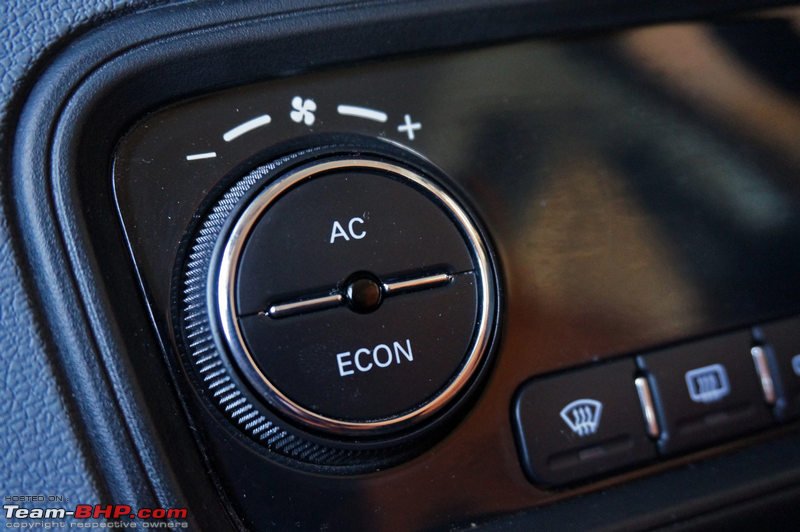 Sweet honeycomb detailing on the tail lamps: 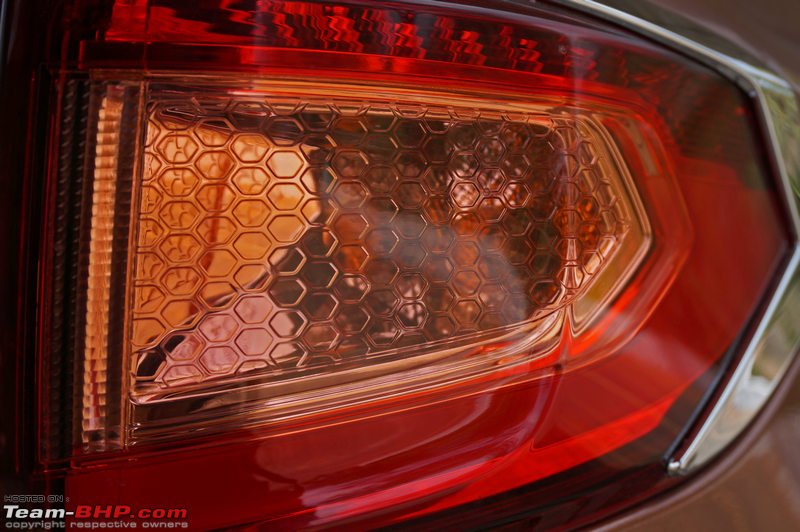 Black moulding available as an accessory. They're added to the sides & bumpers: 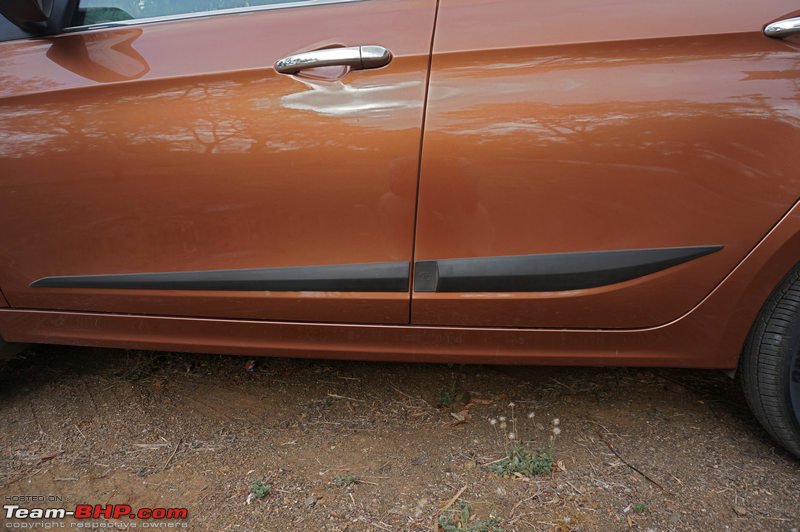 Optional Tigor-branded scuff plates which were there on our borrowed test car: 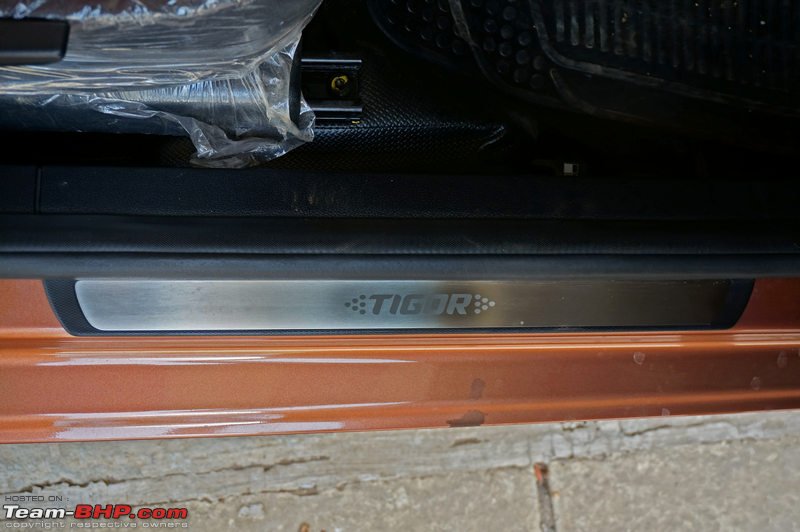 Dual horns - 1 on each side of the grill: 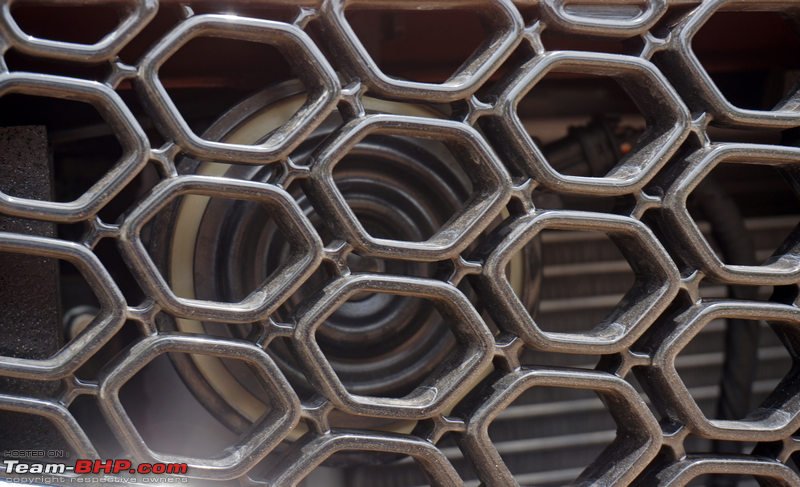 Muffler & tail-pipe are very visible from the back...just like in the Tiago: 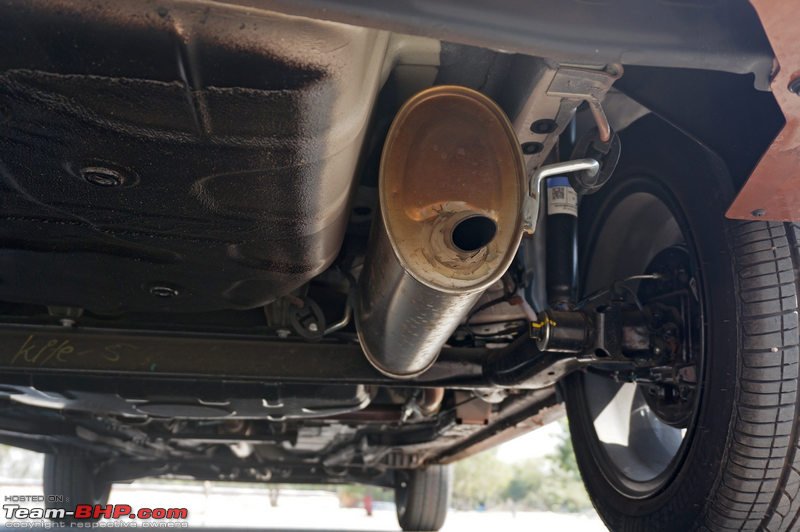 The insulation on the door had already started to come off on our test car: 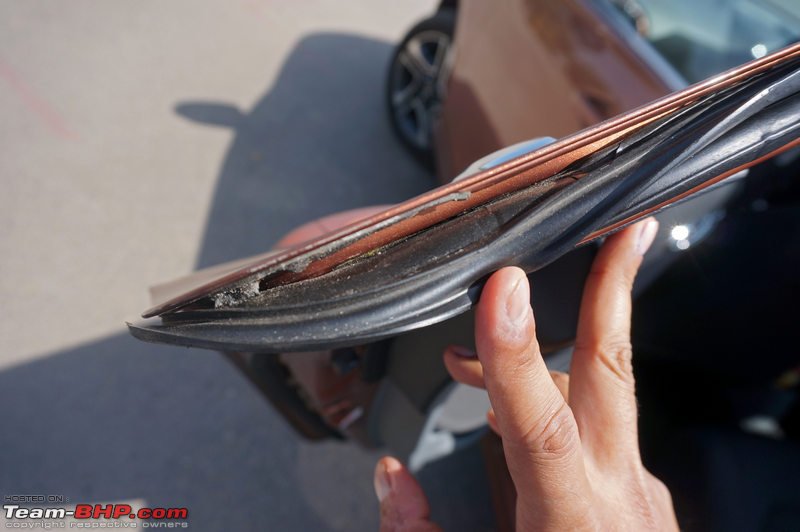 The wipers are the same as the Tiago and have a decent sweep. Also seen here is the flat area above the dashboard to place religious idols: 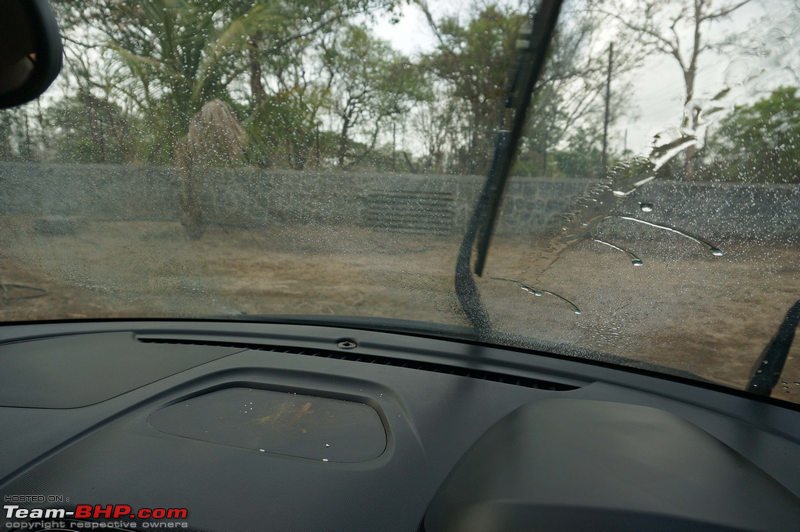 VIN plate is located on the B-pillar near the front passenger seat... 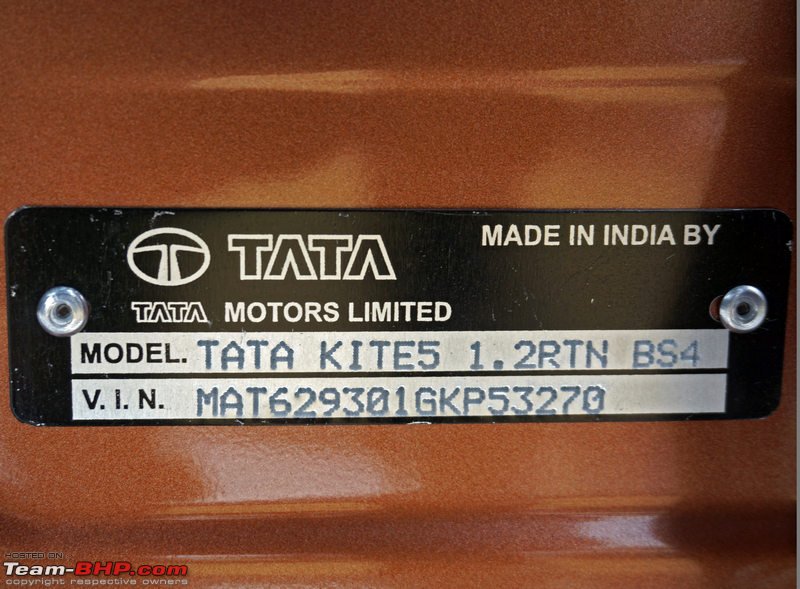 ...and punched near the driver's seat: 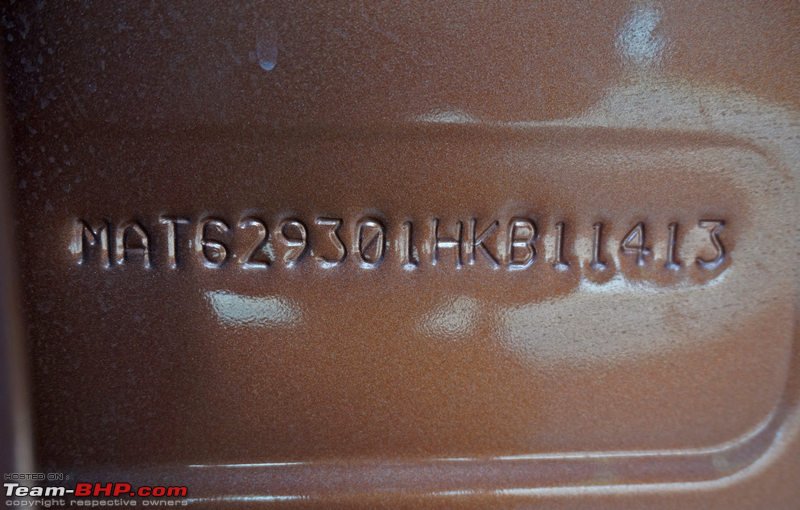 Solar sensor is placed at the end of the dashboard: 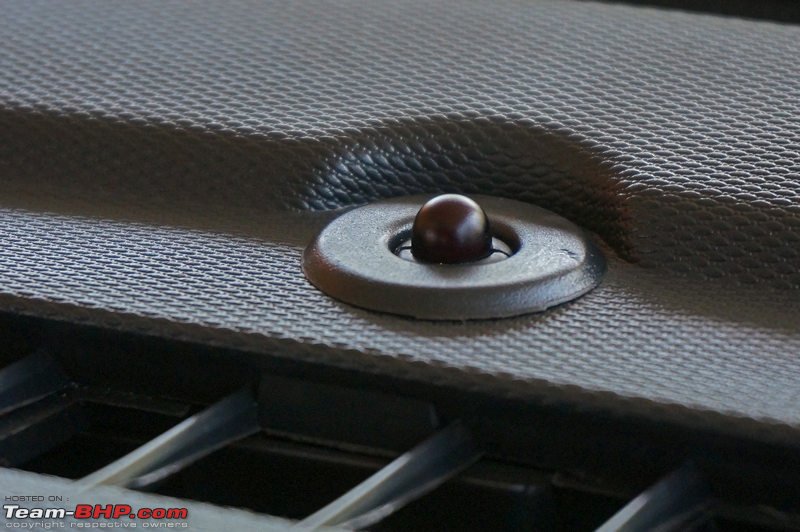 Electric power assist steering from Bosch. Also, on the right side, you will see the OBD port. To access the port, the complete plastic panel on the bottom right of the steering wheel might have to be removed. It should have had more clearance for easier access: 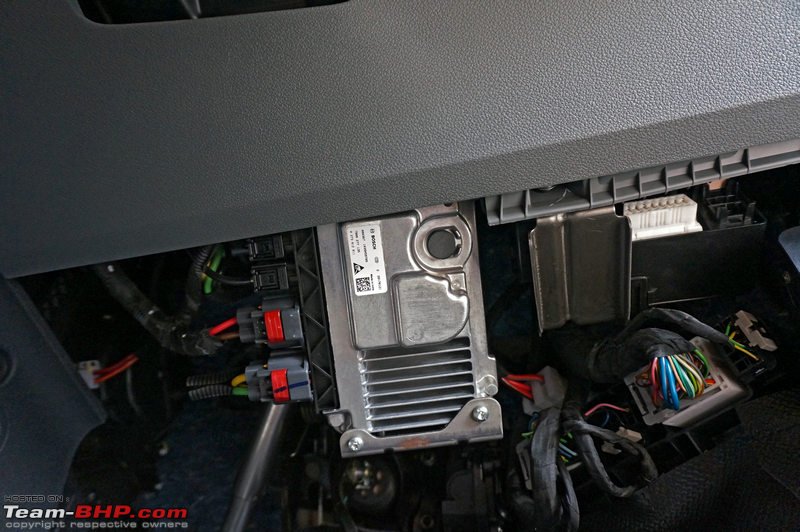 Both sunvisors get a vanity mirror. No illumination. Driver-side sunvisor too has a child-seat warning (not usually the case). The roof liner feels premium (only on the top end variant): 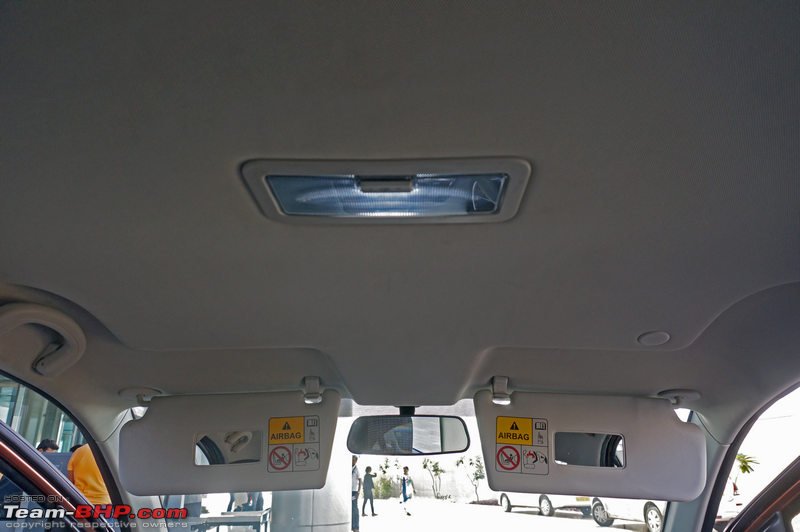 The boot can also be manually opened using this keyhole (new Dzire doesn't...at least our top-end test car didn't): 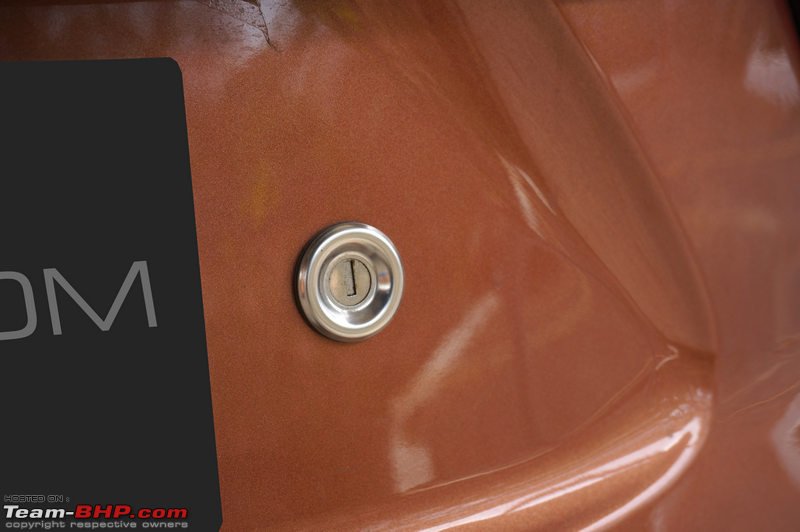 Tata logo on the tail lamp unit. Also notice the rubber stopper to soften the sound when the boot is shut: 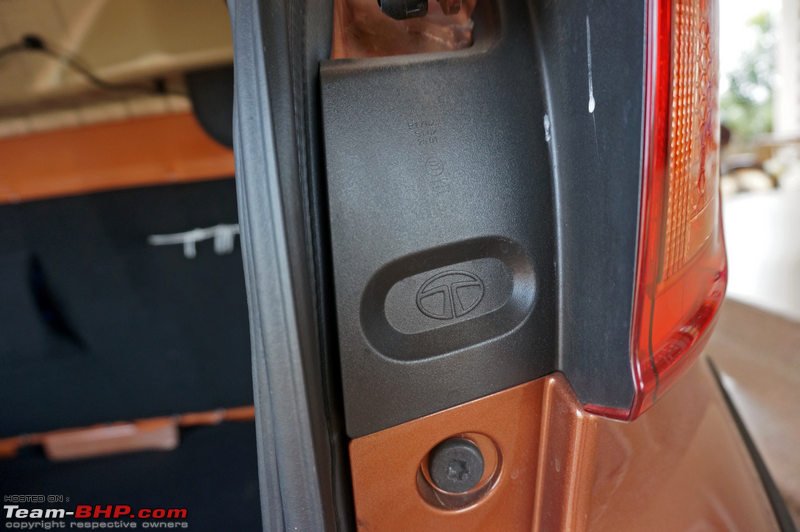 The recommended air pressure levels: 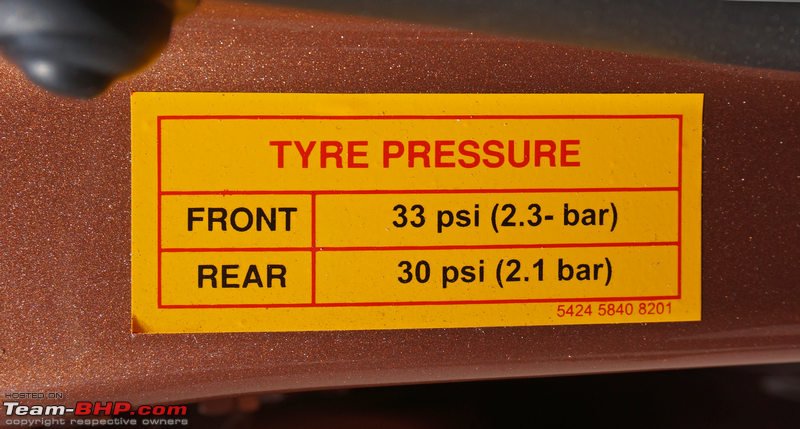 Last edited by GTO : 25th June 2017 at 10:44. |
| |  (29)
Thanks (29)
Thanks
 |
| The following 29 BHPians Thank Omkar for this useful post: | AdityaDeane, Ani0404, AutoIndian, CarguyNish, carrazy, dark.knight, dZired, Enobarbus, GTO, InControl, Ironhide, jagzrk, Karthik Chandra, Nohonking, phoenixash, Ponbaarathi, PraNeel, RavenAvi, S.MJet, sahibrain, sukiwa, sunny29584, supertinu, swiftnfurious, theexperthand, theredliner, vaish9925, vb-saan, VeluM |
| |
| | #12 |
| BHPian Join Date: Jul 2014 Location: Hyderabad
Posts: 386
Thanked: 1,386 Times
| Variant Comparison Posting the variant-wise comparison of Tigor from the details taken from the Tigor website. Common Features: Features common across all the variants. 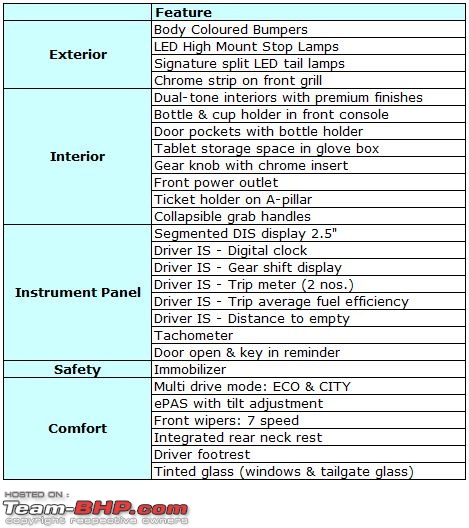 XE vs XT: 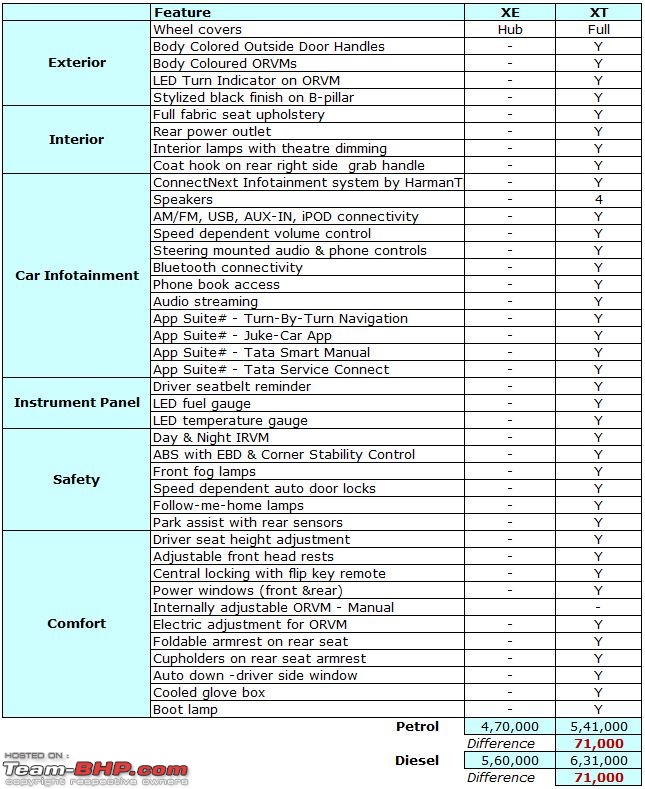 XT vs XZ: 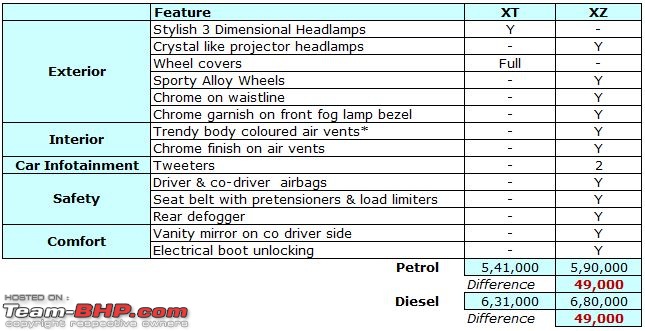 XZ vs XZ (O): 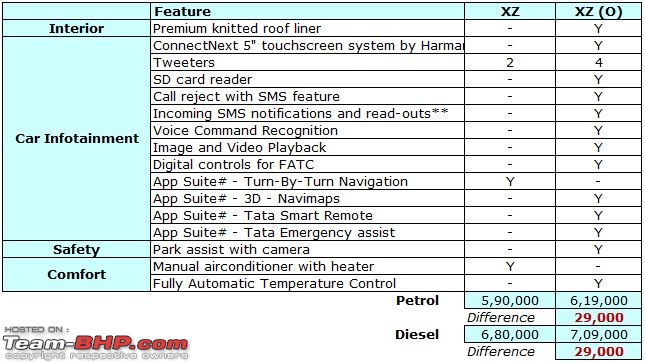 Note: All prices ex-showroom Delhi. Also attaching the excel sheet in case anyone wants to do further customization of the variant comparison. Last edited by GTO : 25th June 2017 at 11:16. Reason: Adding to the official review. Thanks for sharing, man! |
| |  (38)
Thanks (38)
Thanks
 |
| The following 38 BHPians Thank mrbaddy for this useful post: | AdityaDeane, amit_purohit20, Ani0404, arvindmanju, AutoIndian, CarguyNish, carrazy, dailydriver, dZired, Enobarbus, girishglg, GTO, Ironhide, Karthik Chandra, kptraveller, lemedico, Leoshashi, LoneRidder, manij, Motard_Blr, Nagesh Bhatt, nmenon, Nohonking, OrangeCar, Ponbaarathi, Rajeevraj, RavenAvi, RoadSurfer, S.MJet, sahibrain, theexperthand, theredliner, TorqueTwist, uday.ere, vaish9925, VeluM, vijay_rodie, vishy76 |
| | #13 |
| Team-BHP Support  | Re: Tata Tigor : Official Review Thread moved from the Assembly Line to the Official Review Section. Thanks for sharing! Awesome review, Omkar & Eddy - rating a full 5 stars. Also a huge shoutout to Amrut for lending us his family's Tigor  . . |
| |  (15)
Thanks (15)
Thanks
 |
| The following 15 BHPians Thank GTO for this useful post: | amrutmhatre90, chiefpk, InControl, Ironhide, Leoshashi, Nohonking, petroguzzler, Rajeevraj, Ram78, RavenAvi, swiftnfurious, The Rationalist, theexperthand, uday.ere, VeluM |
| | #14 | |
| BHPian Join Date: Mar 2010 Location: Madras
Posts: 461
Thanked: 263 Times
| Re: Tata Tigor : Official Review Quote:
I think only the Vista, Manza, Zest and Bolt were based on the X1 platform. The Indigo eCS was based on the original indica's platform. Last edited by tsk1979 : 25th June 2017 at 12:22. Reason: Thanks, corrected the original post | |
| |  (1)
Thanks (1)
Thanks
 |
| The following BHPian Thanks petroguzzler for this useful post: | GTO |
| | #15 |
| Distinguished - BHPian  | Re: Tata Tigor : Official Review An excellent review as usual. Rating it 5 stars. Special thanks to the owner for lending his priced possession to us.  On a rather angry note, it is truly saddening that Tata couldn't provide us with a test car. Maybe they are too busy with the Hexa here, but the Tigor looks equally promising to me. Poor management. The Tigor is a good choice for those who don't want to stretch their budget for the Swift Dzire. The only thing Tata needs to work on is QC and marketing. The car looks outstanding. Its arguably one of the best sub 4m cars in our market today. The 3 pot engines are a bit of a disappointment really. Tata is developing a new diesel for the Nexon, why not plonk that into the tigor? Last edited by vishy76 : 25th June 2017 at 12:07. |
| |  (2)
Thanks (2)
Thanks
 |
| The following 2 BHPians Thank vishy76 for this useful post: | GTO, Nohonking |
 |



